Editor's Note:
Dear Friend,
It’s official. There are driverless taxis on the streets. It may be six months or six years, but they’ll soon be everywhere, and they will likely change the way we approach car ownership (who needs it?), commutes (ditto) and shopping (assuming the drones don’t corner that market first).
It sounds like a page from a sci-fi script, but this is real life, and we are in it.
If artificial intelligence continues to grow exponentially—and it seems to be a foregone conclusion that it will—then many of us will find ourselves with a lot of time on our hands. How the market will reform to accommodate so many consuming humans in a world where production requires so few humans is anyone’s guess. Yes, it’s scary. No, there is little most of us can do about it.
Best-case scenario: There will be lots of goodness to go around, and everyone will have what he or she needs in abundance. To quote the words of Maimonides: “In that era there will be neither famine nor war, neither envy nor strife, because good will emanate in abundance and all delightful things will be accessible as dust. The one preoccupation of the entire world will be solely to know G‑d.”
May it indeed be so. Amen!
Menachem Posner
on behalf of the Chabad.org Editorial Team
PS: How do you feel about driverless cars? Would you be comfortable in one? Do you think they are a step in the right direction? Please share a comment and let us know.
-------
 Dissatisfied on Purpose
Dissatisfied on PurposeSo you are not happy with the way things are in your world, your community, your house, your own self.
Who says things were designed to make you happy? G‑d Himself is dissatisfied with all of it. He made such a world and put you here within it to do your part in fixing it.
Be strong and take on a load, and rejoice that soon will be a world which you had a hand in building.[Yechidut, Elul 2, 5720 (English).]
-------
This Week's Features
Printable Magazine
-------
-------
 The Philanthropic Pauper by Mendel Kalmenson
The Philanthropic Pauper by Mendel Kalmenson 
Here's G‑d on the topic of charity:
Be careful lest a reckless thought enter your heart saying, "The seventh year, the year of cancellation [of loans] is approaching," and you look begrudgingly at your destitute brother and do not give him…Rather you should give him repeatedly, and your heart should not feel bad when you give to him. For as a result, G‑d, your G‑d, will bless all your work and everything you do...—Deuteronomy 15:9-10.
To paraphrase: Even in tough times keep your hearts and pockets open for those who have less than you do.
This excerpt from G‑d's public address to our ancestors seems to be reflected in a Jewish teaching recorded in the Code of Jewish Law, which stipulates that: "Everyone is obligated to give charity. Even people supported by charity must contribute from what they receive."
This law seems radical on the one hand, and absurd on the other.
This obligates the wealthy to provide the poor with enough money not only to live, but to give!Radical in that it demands of a man so poor as to need handouts himself, to provide assistance for others in need. The pauper is obligated to become a philanthropist even as he himself is the subject of philanthropy!
And absurd in that effectively this law obligates the wealthy to provide the poor with enough money not only to live, but to give! If the pauper donates some of the donations he receives, he's left with less and automatically needs more.
This instance is but one example of Judaism's profound departure from conventional moral thought.
Your typical code of ethics would not only exempt the poor man from giving charity, it would forbid him from doing so, due to the fact that his "generosity" comes at the expense of his benefactor, and additionally because depleting his finances any further solidifies his dependency on support.
Besides, since when does giving charity qualify as one of life's necessities; so why include that in the rich man's moral obligation towards the poor?
It's here that the Torah redefines the thing we call charity.
The kabbalists teach that before creating our world, G‑d was looking to exercise and express His kindness. But you can't do charity with yourself; it's like taking money from one pocket and putting it in another.
So He created the world and its inhabitants in order to give, making us beneficiaries of the first known act of charity.
Apparently, then, man is a taker by birth.
The moment we stop giving part of us stops livingHerein lays the novelty of the Biblical verse which tells that "G‑d created us in His image."
As He is essentially a giver, so are we.
While the reason we were created was in order to take, the manner in which we were created – in his image – leaves us with an inherent need to give. It's part of our spiritual and moral make-up. It's necessary if we want to keep up our (divine) image.
The moment we stop giving part of us stops living.
Giving then is not a luxury but a necessity of life. This is not about what we do; it's about who we are; it's part of our definition.
Reaching out, then, is really reaching in.
Consequently, since giving charity means providing a poor man's needs, and giving charity so happens to be one of them, denying him that necessity of life is like denying him life itself.
How wrong it would be to let a pauper lose touch with his inner self, even if only for a short period of time; and how right it is, then, to include in his aid-package the wherewithal to give charity.
Giving is what makes us tick, like nutrition, energy, and oxygenIn Judaism giving is not just a hobby, repaying a debt to society, or even just the good or right thing to do; it is, rather, part of what makes us tick, like nutrition, energy, and oxygen.
In ways it's even more than those, for they contribute to the physical part of us that comes and goes, while the charity and good deeds we do give birth to the part of us that lives on forever in the memories of our beloved, contributing to the collective human legacy of giving.
So although sometimes we are forced to take in order to live, giving is life itself.
Rabbi Mendel Kalmenson is the rabbi of Beit Baruch and executive director of Chabad of Belgravia, London, where he lives with his wife, Chana, and children.
Mendel was an editor at the Judaism Website—Chabad.org, and is also the author of the popular books Seeds of Wisdom and A Time to Heal.
Artwork by Sefira Ross, a freelance designer and illustrator whose original creations grace many Chabad.org pages. Residing in Seattle, Washington, her days are spent between multitasking illustrations and being a mom.© Copyright 2016, all rights reserved.
-------
YOUR QUESTIONS
How Do I Know If I Am a Jew? By Menachem Posner
 Lots of folks wonder if they are Jewish. It may be that they feel an inner pull toward Judaism and Jewish people. It may be that there was a secrecy among the older generation that leads them to believe that the family tree is more tangled (and fruitful) than what meets the eye. It may be an unusual family name or unusual family traditions. Or it may just be curiosity.
Lots of folks wonder if they are Jewish. It may be that they feel an inner pull toward Judaism and Jewish people. It may be that there was a secrecy among the older generation that leads them to believe that the family tree is more tangled (and fruitful) than what meets the eye. It may be an unusual family name or unusual family traditions. Or it may just be curiosity.So how are we to determine who is Jewish, and what are we to do with the information once we have it?
The Basics
Judaism is passed on exclusively through the biological female line. This means that if you trace your Jewish lineage through your mother’s mother’s mother’s mother (etc.), you are Jewish, even if all other branches of your family are not Jewish.
(On the flip side, if your maternal line leads to a non-Jew, even if you live in New York, eat bagels with a schmear, and are deathly afraid of dogs, you are not a Jew.)
But Judaism is not only conferred by blood. If you convert to Judaism under the auspices of a bona fide Orthodox beit din (ecclesiastical court), you are 100% Jewish, and so are all offspring born to you after your conversion (if you are female).
In Practice
If you have been living as a Jew as part of the Jewish community for your whole life (as has your biological family for as long as anyone knows), it is safe to assume that you are Jewish. The same would apply to someone who either converted or is the direct descendant of a (female) convert.
If you have been living as a non-Jew and wish to establish your maternal Jewish heritage, you may need to provide more evidence than “I once asked asked Aunt Charlene if we were Jewish and she stared back at me blankly.” For a host of reasons beyond the scope of this article, genetic testing would not be sufficient either.
It’s not that the Jewish community is hostile toward people who’ve dropped their tribal affiliation for a generation or two. It’s just that they want to make sure that you are indeed a member of the tribe before establishing you as such.
Chances are that you’ll need to dig for old documents (or a Jewish person who can actually testify about your ancestor’s Jewishness).
The exact type of documents needed can vary widely. For example, in Russia, Jewish people had their ethnicity written in their passports. The problem is that the Russians sometimes considered the children of male Jews to be Jewish. In addition, many people purposely got rid of the dreaded “fifth line” in their passport, since systemic anti-Semitism made it hard for Jews to advance in Soviet society. Thus, the passport of a great-grandmother who was born before intermarriage became common would possibly be a good piece of evidence.
In some parts of Canada, legally-recognized birth records were typically kept by synagogues until the 1990s. Thus, a record of birth or marriage from an Orthodox synagogue would be very significant. In the U.S., by contrast, synagogues did not keep such good records, and whatever was recorded often disappeared when old congregations closed. There is a much smaller chance of finding a conclusive document of Jewish identity deep in an archive.
There are rabbis and rabbinical documents that specialize in documentation from various parts of the world. Rabbis who have experience in this field may often be skeptical. Experience has taught them that documents can be forged, and they have learned to ask hard questions and dig deeply before conclusively identifying a person as Jewish.
But that should not stop you from digging. After all, if you do not look, the odds of finding anything are even smaller.
If you discover Jewish ancestry deep in maternal past, but have been living as a non-Jew, it is customary for you to dip in the mikvah, not as a conversion (since you already are Jewish), but to symbolize a clean break from your non-Jewish past.
I’m Jewish, Now What?
For some folks, discovering that they are Jewish is mind-blowing. They suddenly need to become part of an unfamiliar community and learn a new culture, belief system and way of life they may not even have known existed. The good news is that you can and should take it slowly. Get out a few books from the library, sign up for some emails from Chabad.org, and get to know the folks at your closest Chabad House.
G‑d knows you well (after all, He created you). He does not expect you to scale the wall in one day. Grow a bit in your Jewish knowledge every day, and add slowly but surely to your Jewish observance. Gradually, you’ll feel more and more an integral member of the Jewish community. It may take a year. It may take a decade. But there will come a time that you’ll look around yourself and say, “Yes, this feels like home, and I am comfortable here.”
What Happens If You Draw a Blank?
There are some folks who have good reason to believe that they are Jewish but lack the documentation to prove it. If you are such a person and you are truly committed to living a Jewish lifestyle (Shabbat, kosher, etc.), you may undergo what is known as giyur lechumra, a conversion just to be on the safe side.
What happens if you discover that you have paternal Jewish ancestry or can uncover no concrete knowledge of a Jewish past at all?
You have a choice. You can continue to live as a non-Jew with a special connection to Judaism and Torah. Living under the rubric of the 7 Noahide Laws, you can maintain (and grow in) your status as a good friend of the Jewish people even if you are not a Jew.
And if you wish (and circumstances allow for it), you may choose to convert to Judaism. Only conversion done by a bona fide Orthodox beit din will achieve your goal, so make sure to do this one right.
In very short, conversion consists of learning about and then accepting the Torah’s commandments, circumcision (for a male) and immersing in a mikvah, all under the guidance of the beit din. Note that once you convert, there is no going back. You’ll be obligated to live a full Jewish life, so make this decision carefully.
Why Me?
It is perfectly normal to question why G‑d sent you down this circuitous route. Why could you not have been born to a family named Goldstein in Brooklyn and sent to day school with a bunch of fellow Jews? We may never know the answer to this question. We do know, however, that nothing is by accident.
Everywhere in the world, there are sparks of holiness waiting to be elevated. It is the purpose of the Jewish people to encounter these sparks and bring them back to their source in heaven. Some of those sparks are easy to find. But the most precious sparks of all are the ones hidden in the darkest, deepest corners.
Every single soul has a specific mission in life, and the hardiest, holiest souls are tasked with the most difficult missions of all: bringing back the most special sparks. Perhaps your soul is one of those brave few who have the wherewithal to serve G‑d in the unique circumstances G‑d placed you in.
This may not make the load any lighter, but it does tell us that you are not being punished or rejected. On the contrary, G‑d gave you this difficult path because he believes in you. And if He believes in you, so should you believe in yourself.
Useful links:
- What to Expect at a Conversion
- Why Is Conversion to Judaism So Hard?
- The Discovery of Planet Earth (on the Seven Noahide Laws)
- Should I Convert to Judaism?
- I Just Discovered I Am Jewish. What Do I Do Now?
Artwork by Sefira Ross, a freelance designer and illustrator whose original creations grace many Chabad.org pages. Residing in Seattle, Washington, her days are spent between multitasking illustrations and being a mom.© Copyright 2016, all rights reserved.
-------
Your Questions
Why Is the Shofar Not Blown on Shabbat? by Naftali Silberberg
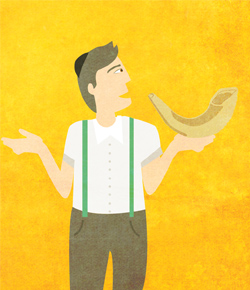 Though sounding the shofar (ram's horn) on Rosh Hashanah is a biblical precept1 – no matter what day of the week the holiday may fall on2 – the Mishnah3 tells us that we do not sound the shofar when Rosh Hashanah falls on Shabbat:
Though sounding the shofar (ram's horn) on Rosh Hashanah is a biblical precept1 – no matter what day of the week the holiday may fall on2 – the Mishnah3 tells us that we do not sound the shofar when Rosh Hashanah falls on Shabbat:If the holiday of Rosh Hashanah falls on Shabbat, the shofar is sounded in the Holy Temple,4 but not in the Land.
The Talmud5 gives us the explanation for this surprising law:
Rabbah said: All are under obligated to blow the shofar, but not all are skilled in the blowing of the shofar. Therefore, there is a danger that one will take the shofar and go to an expert to learn [how to properly sound it], and he will carry it four cubits in the public domain [—an act that is forbidden on the Shabbat].6
Indeed, the Sages are empowered to "overrule" a Torah precept (if their instruction involves restraint from action, not a proactive violation of a biblical command).7 Our obligation to follow such directives is implicit in the verse,8 "And you shall do according to the word they tell you, from the place that G‑d will choose, and you shall observe to do according to all they instruct you."9
In numerous chassidic discourses10 it is explained that it is inconceivable that the Sages would deprive all of Israel of the benefits afforded by one of the greatest mitzvot we have—simply on account of a few ignorant souls who might otherwise err. We must conclude that the Sages understood that on Shabbat it is actually unnecessary to blow the shofar, for that which we normally accomplish through sounding the shofar is, of its own accord, accomplished on Shabbat.
The accomplishment of the shofar is to renew G‑d's pleasure in His works, especially this world, so that there will be a desire to continue infusing His works with the life force necessary for their continued existence. If He delights in us, then He has reason to continue creating us, reason to continue His relationship with us. (For more on this, see The Kabbalistic Spin on Rosh Hashanah.)
The principal theme of Shabbat is also pleasure, delight and desire. "Call the Shabbat a delight," the prophet enjoins us11—which we accomplish by partaking of sumptuous meals.12 And that which G‑d instructs us to do, He also does Himself.13 If so, on Shabbat the delight and desire to continue with our world and with our relationship is already there—no need to blow the shofar to renew it.
(Nevertheless, there are many gradations to pleasure. The level of Divine pleasure evoked through blowing the shofar in the Holy Temple – the location where G‑d's essence was manifest – is greater than the pleasure naturally activated on Shabbat. As such, the shofar is sounded in the Temple even when Rosh Hashanah falls on Shabbat.)
Soon, we hope to merit hearing the "great shofar" that will be sounded on the day of the Redemption: "And it shall come to pass on that day, that a great shofar shall be sounded, and those lost in the land of Assyria and those exiled in the land of Egypt shall come, and they shall prostrate themselves before G‑d on the holy mount in Jerusalem."14
The "great shofar" symbolizes the ultimate level of pleasure, far greater even than the pleasure evoked in the Holy Temples of yore: the pleasure that G‑d takes in each and every one of His children. It is this pleasure that will be felt and manifest.
Indeed it is this immense revelation, this grand sounding of the shofar, that will reach the hearts of even the most distant of Jews – those lost in the land of Assyria and exiled in the land of Egypt – and kindle within them the desire to return to where they really belong: the holy mount in Jerusalem.15
Wishing you and yours a sweet new year,
Rabbi Naftali Silberberg,
Chabad.org Editorial Team
Rabbi Naftali Silberberg is a writer, editor and director of the curriculum department at the Rohr Jewish Learning Institute. Rabbi Silberberg resides in Brooklyn, New York, with his wife, Chaya Mushka, and their three children.
Artwork by Sefira Ross, a freelance designer and illustrator whose original creations grace many Chabad.org pages. Residing in Seattle, Washington, her days are spent between multitasking illustrations and being a mom.
FOOTNOTES
1.Numbers 29:1: "And in the seventh month, on the first day . . . it shall be a day of shofar sounding for you."
2.And though the sounding of the shofar on Shabbat violates no biblical precept—as it's not included in any of the 39 creative works forbidden on the Day of Rest. (The Sages nevertheless forbade the sounding of the shofar on any Shabbat, because it is a "weekday-like activity." See Alter Rebbe's Shulchan Aruch, Orach Chaim 588:4.)
3.Rosh Hashanah 29b.
4.Following the destruction of the Temple, the authorization to blow the shofar on Shabbat was transferred to wherever an ordained Sanhedrin (Rabbinical Supreme Court) was convened, for in such a setting there's no fear that an ignorant person will carry the shofar in the public domain. Today, however, there is no such ordained court.
5.Ibid.
6.The Talmud concludes that for the same reason we don't take the Four Kinds on Shabbat, nor do we read the Scroll of Esther if Purim were to fall on Shabbat.
7.See Talmud Yevamot 89b-90b. This authority is subject to many limitations. For example, the Sages can only use this power in order to preserve another Torah statute (as in our case, the Torah prohibition against carrying in the public domain on Shabbat), and they don't have the ability to completely abolish a Torah rule (e.g., to decree that we never fulfill the mitzvah of blowing shofar, no matter on which day the holiday falls). For more on this topic, see Encyclopedia Talmudis vol. 25, entry Yesh Koach B'yad Chachamim La'akor Davar Min HaTorah.
8.Deuteronomy 17:10.
9.It should be noted that the Jerusalem Talmud (Rosh Hashanah 4:1) maintains that the original biblical command to sound the shofar on Rosh Hashanah only applied to when Rosh Hashanah falls on a weekday. This they extrapolate from two seemingly conflicting verses regarding blowing the shofar on Rosh Hashanah:
One verse (Numbers 29:1)tells us: "It shall be a day of shofar sounding." Another verse (Leviticus 23:24) tells us: "In the seventh month, on the first of the month, it shall be a Sabbath for you, a remembrance of the shofar blast."
Why here does the Torah tell us that on Rosh Hashanah we merely "memorialize" the shofar blasts? The Talmud explains that this verse refers to when Rosh Hashanah falls on Shabbat, in which instance we only recall the sounds of the shofar, through reciting verses that discuss the shofar, but we do not actually sound it.
10.The original source of this concept is in Likutei Torah by Rabbi Schneur Zalman of Liadi, Derushei Rosh Hashanah 56a ff.
11.Isaiah 58:13.
12.Alter Rebbe's Shulchan Aruch, ibid. 242:1.
13.Midrash Rabbah Exodus 30:9.
14.Isaiah 27:13.
15.See Sefer Hamaamarim Melukat vol. 6, d.h. Vehaya Bayom Hahu.© Copyright 2016, all rights reserved.
-------
Parshah
The Most for the Least by Chaya Shuchat
 The final project in my calculus class was to write an essay about the real-world application of some concept we had learned in the course.
The final project in my calculus class was to write an essay about the real-world application of some concept we had learned in the course.I liked that. What better way to integrate my learning than to think about its implications in everyday life?
I didn’t have to think far. I wrote about my favorite function, the maxima-minima.
The maxima-minima function is used to solve problems like: What is the lowest price I should charge for an item to make the maximum profit? What is the fastest I can drive my car and still achieve the best gas mileage? When building a house, what are the ideal dimensions to use the least possible amount of building materials?I didn’t have to think far
Problems like these so perfectly encapsulate the basic dilemma of life. Every decision involves a tradeoff of some sort. I must give up something that I want in order to get something else. Speed versus efficiency. Safety versus convenience. Quality versus quantity. Short-term pleasure versus long-term health. We make these decisions consciously or unconsciously dozens of times per day, whenever we choose how to allocate our time, money or other resources. What is the least I must give up to get the most of what I want?
In this week’s Torah portion, we find the mitzvah of aser te’aser, literally translated as “Tithe you shall tithe,” referring to the obligation to set aside a tenth of our earnings for charity.1 Since the word for “tithing,” aser, has the same root as “wealthy,” ashir, the Talmud interprets this verse as “Tithe in order that you shall become wealthy.”2
Now, that sure defies all the laws of calculus and economics! If I give up a tenth of my earnings to charity, then obviously there is a tenth less for me—a tenth less for me to invest or to spend on any of my needs.
But the true value of money depends on so many variables that we can neither predict nor control. Will my investments succeed or fail? Will I derive satisfaction from my earnings, or will my money go toward medical bills, legal expenses or other aggravations? Even if I have enough money to enjoy the tangible pleasures of life—a nice car, fine dining, vacations—will I have enough of the intangibles, such as strong relationships and meaningful goals, to make it all seem worthwhile?
What am I really giving up by tithing? I think what we are most afraid of is not giving up our money but giving up control. When I choose to buy a car, I can do research; I can even plug in my maxima-minima functions to find the best possible car at the lowest possible price within my budget. Once I buy the car, I can trade it in, sell it or upgrade it, and I can buy insurance to offset any possible loss or damage.
But giving tzedakah, charity, has no such guarantee. I am giving up something that I earned through the sweat of my own brow, to be enjoyed by someone else who didn’t put the same effort into it. Once I give up the money, it’s gone—I have no further say in how it will be spent (unless I want to be an insufferable control freak). This is why the book of Tanya states that giving charity is equivalent to all other mitzvahs.3 While other mitzvahs might use a specific part of the body (tefillin on the hand and head, for example), charity involves giving money that we earned with our time, talent and expertise, money that we could have used for any of our human needs. Giving up our money is the closest we can come to giving up ourselves.
So, what is the maximum amount of money I should give up for What I receive in return has no minimum or maximumcharity, and what do I get in return? Jewish law is clear on the minimum and maximum recommended amounts to give to charity: not less than one-tenth and not more than one-fifth of your income. (In some situations, it may be appropriate to give more or less than these amounts; a rav should be consulted.)
But what I receive in return has no minimum or maximum. It is truly infinite. It is a Divine promise for success in our endeavors—success that will give us the ability to truly enjoy and make use of the bounty we are given. G‑d even invites us to challenge Him with the mitzvah of charity, to see if the money we tithe is repaid. “Please, test me with this,” says G‑d.4
The concept of tzedakah is especially pertinent now, when we are in the seven-week consolation period following the Jewish day of mourning on the 9th of Av. “Zion will be redeemed with justice, and its captives with charity.”5 Giving tzedakah is a unique opportunity to bring holiness and blessing into every aspect of our lives, and thereby merit the ultimate redemption.
Chaya Shuchat is the author of A Diamond a Day, an adaptation of the chassidic classic Hayom Yom for children, as well as many articles on the interface between Chassidism and contemporary life. She is a pediatric nurse practitioner with a master’s degree in nursing from Columbia University.
Artwork by Sefira Ross, a freelance designer and illustrator whose original creations grace many Chabad.org pages. Residing in Seattle, Washington, her days are spent between multitasking illustrations and being a mom.
FOOTNOTES
1.Deuteronomy 14:22.
2.Taanit 9a.
3.Likkutei Amarim, ch. 37; Iggeret Hakodesh, ch. 4.
4.Malachi 3:10; see also Tur, Yoreh De’ah 247.
5.Isaiah 1:27.© Copyright 2016, all rights reserved.
-------
Parshah
Why the Soul Loves the Body by Menachem Feldman
 Body and soul are opposites. The soul wants nothing more than to escape heavenward, to leave its existence in this world and reunite with its Infinite Source. The body, on the other hand, seeks to experience an earthly life full of earthly pleasures. The body is not interested in abstract spiritual concepts. The body craves instant, tangible gratification.
Body and soul are opposites. The soul wants nothing more than to escape heavenward, to leave its existence in this world and reunite with its Infinite Source. The body, on the other hand, seeks to experience an earthly life full of earthly pleasures. The body is not interested in abstract spiritual concepts. The body craves instant, tangible gratification.How then do the body and soul unite so smoothly to become the human being? Why is the soulThe body craves instant, tangible gratification not at war with the body's gravitational pull? Why does the soul not escape the confines of the body?
The Kabbalists teach that the Divine energy that creates the world—the “soul” of the world—is comprised of two parts: light and vessels. The light is the undefined energy, and the vessels express the energy in a limited and defined way.
Just like the human body and soul, the vessels and light are opposites. The light seeks to escape upward and reunite with its Infinite Source, while the vessels are happy to maintain their own distinct personality. Why then does the light bond with the vessels? Why does the light not retreat to its source?
Let us understand this by way of a parable:
A brilliant professor taught in graduate school, where he had many gifted students who understood the depth of his teaching and appreciated his profound insights. One day, the professor invited his students to join him on a visit to a first-grade classroom, where he would explain his latest discoveries to the children. Understandably, the graduate students declined to join him. They preferred to experience their great professor’s brilliance in graduate school, not in grade school. They had no desire to limit their learning to the intellectual capacity of a first-grader.
One student, however, decided to go along with his professor. The student understood that for a theory to be projected to the distant world of a first-grader, the professor would need to reach far deeper within himself. In order to communicate with people so intellectually far from himself, he would search for and discover the essence of the idea. The student understood that the first-grade classroom was the place where the professor’s true brilliance would be expressed. The ability to communicate with a distant reality comes from the deepest resources of one's intellect.
And so, as the first-graders were listening to the older gentleman talk, they were oblivious to the greatness of his wisdom. They would have preferred to play with the toys piled up in the back of the classroom. Yet the graduate student marveled at every word that emerged from his teacher's mouth. Never before had he experienced this element of the professor's awesome intellectual power. Never had he heard such deep ideas expressed in such simple words. Interestingly, the first-graders, the cause of this revelation, were not mature enough to appreciate it. It was the graduate student alone who appreciated the lofty nature of what was transpiring in the first-grade classroom.
Similar to the graduate student appreciating the lecture given to the first grade, the soul appreciates the greatness of the body. The body, like the first-graders, does not understand that the body is a deeper expression of G‑d’s greatness than is the soul. In order to create a body, in order for G‑d to express His energy in a spiritually distant place, G‑d must express an even deeper part of Himself. And yet, it takes a soul to understand the great spiritual source of a body.
And so it is with the Divine light. It, too, feels that the vessels, specifically because they are limited and defined, are rooted in a higher place within the Divine. The undefined abstract light senses that the creation of vessels is G‑d projecting a deeper part of Himself.
This, then, illuminates Judaism's attitude toward all things physical. Physicality, left to its own devices, is empty of spiritual light and is a distraction from one’sIt takes a soul to understand the great spiritual source of a body purpose in life. Yet when the soul engages with the physical, the soul reveals the truth, that physicality is a greater expression of the awesome power of G‑d. For when an infinite G‑d expresses Himself in a finite realm, that is the true indication of His infiniteness.
In Parshat Re’eh, the Torah describes the Jew’s ultimate spiritual experience during the thrice-yearly pilgrimage to Jerusalem:
And you shall eat before the L‑rd, your G‑d, in the place He chooses to establish His Name therein, the tithes of your grain, your wine and your oil, and the firstborn of your cattle and of your sheep, so that you may learn to fear the L‑rd, your G‑d, all the days.1
How does the Jew reach the epitome of spiritual heights? By eating his grain, wine, oil, cattle and sheep!
For light feels the superiority of the vessels. The soul feels the superiority of the body. And the Jew senses that if while engaging in delicious meat and wine he can simultaneously experience a spiritual joy, he has reached the essence of G‑dliness.
Rabbi Menachem Feldman serves as the director of the Lifelong Learning department at the Chabad Lubavitch Center in Greenwich, Conn.
Artwork by Sefira Ross, a freelance designer and illustrator whose original creations grace many Chabad.org pages. Residing in Seattle, Washington, her days are spent between multitasking illustrations and being a mom.
FOOTNOTES
1.Deuteronomy 14:23. © Copyright 2016, all rights reserved.
-------
Parshah
The Power of Sight by Eli Touger
1.Deuteronomy 14:23. © Copyright 2016, all rights reserved.
-------
Parshah
The Power of Sight by Eli Touger
 Adapted from
Adapted from Likkutei Sichos, Vol. IV, p. 1339ff; Vol. XV, p. 44;
Sefer HaSichos 5750, p. 631ff;
Sefer Sichos 5751, p. 767ff;
Sichos Shabbos Parshas Re’eh, 5745
Penetrating Perception
Our Sages state:1 “A witness may not serve as a judge.” And they explain the rationale: “Once a person has seen [a crime] committed, he can never find justification for the perpetrator.” This teaches us that sight does more than convey information. When a judge hears the details of a crime from witnesses, he can still think objectively about the matter and consider the merits of the defendant. If, however, he himself has seen the crime perpetrated, he will be too deeply affected to contemplate the matter without bias.
Seeing and hearing operate differently. When a person sees an event or an object, it penetrates beyond his conscious mind. The impression created remains with him, strong and powerful. When, by contrast, he hears about the matter, even if his source is reliable, such a connection is not established, and his conception of the issue is strictly intellectual. Therefore, he can weigh it dispassionately, and understand other points of view.
There is another difference between these two senses: When we see an object or an event, we grasp it in its totality, and only afterwards do we focus on the particulars. When we hear, by contrast, we begin with the particulars and work toward comprehension of the entire picture.
These two points are interrelated: Because one sees an entity in its totality, the experience penetrates deeper. And conversely, when one hears only the particulars, it is easier to be influenced by additional points of information.
To Serve G‑d by Choice
These concepts are relevant with regard to this week’s Torah reading, Parshas Re’eh, which begins:2 “See that I am placing before you today a blessing and a curse.” The portion continues to allude to free choice, reward and punishment:3 “The blessing [will come] if you obey the commandments… and the curse [will come] if you do not heed… and go astray from the path which I have commanded.”
Moshe is telling the people that their observance of G‑d’s commandments will not be a spontaneous response. Instead, they will constantly be required to make conscious choices.
Why does G‑d grant man choice? To elevate him to a higher plane of Divine service.4 Were man’s choice between good and evil to come naturally, he would not have any sense of accomplishment. What would he have earned?
For this reason, man is confronted at every stage of his spiritual progress with challenges which he must overcome on his own.5 By nature, evil has no substance, and as darkness is repelled by light, evil would be instantly subdued by the power of holiness. But in order to allow free choice to operate, evil is granted the power to present an obstacle to the forces of holiness. Indeed, the forces of evil are granted sufficient strength to parallel even the highest spiritual levels, for there must always be an evil and a good to choose between. For this reason, we see that the choice to pursue material gain can at times extend beyond a person’s understanding, to the point that he is even willing to risk his life for these goals.
Nevertheless, these challenges have one purpose: that man face them and overcome them. The good which man manages to spread in the world thus becomes his own doing. He is not merely a recipient of Divine favor; he makes a contribution of his own.6
Sight as Assistance, a Command, and a Promise
On one hand, the challenges man confronts must be real. If they do not require that he tap his inner resources to overcome them, they do not grant him the opportunity to realize these powers of achievement.
On the other hand, G‑d does not want man to fail. He invests within him the power to overcome the challenges he faces, and aids him at every step along the way. One of the means of empowerment is alluded to in the above verse: “See that I am placing before you….” G‑d allows man to see the truth of “the blessing and of the curse.”7
As explained at the outset, when something is seen, a deep impression is made. When man sees the nature of the good he can achieve through the correct choice, and when he sees that the entire reason evil has been given substance is to allow him to make that choice, he will surely choose positively.
Alternatively, the word “see” can be interpreted as a command.8 The objective of man’s Divine service should be to reach a state that enables him to see the Divine purpose in his life. When this purpose is “seen,” and not merely comprehended intellectually, he will feel inspired to carry out his Divine service with increased vigor. Moreover, the word “see” can also be interpreted as a promise that we will in fact reach this level of awareness.
Seeing the Truth
The ultimate expression of the potential of sight will be in the Era of the Redemption, with the fulfillment of the prophecy:9 “The glory of G‑d will be revealed and all flesh will see.” In contrast to the present era, when we can see only material entities and G‑dliness is perceived as an external force, in that future time, we will see directly how G‑dliness is the truth of all existence.
Nor is this merely a promise for the distant future. The Redemption is an imminent reality, so close that a foretaste of its revelations is possible today. Indeed, it is already possible to see10 manifestations of the blessings of Redemption in the events which have occurred to the Jewish people in the recent past.
FOOTNOTES
1.Rosh HaShanah 26a; see Likkutei Sichos, Vol. VI, p. 121.
2.Deuteronomy 11:26.
3.Ibid.: 27-28.
4.See also the essay “Choosing Our Mission” in this series, which also touches on the concept of free choice.
5.The importance of man’s initiative reflects a connection to the monthly cycle of the Jewish year. Parshas Re’eh is read either on the Shabbos on which the month of Elul is blessed or on Rosh Chodesh Elul. The name Elul (אלול) serves as an acronym for the Hebrew words אני לדודי ודודי לי, which mean “I am my Beloved’s and my Beloved is mine” (Song of Songs 6:3). Our Rabbis (Or HaTorah, Parshas Re’eh, p. 791) interpret this phrase to indicate that man takes the initiative in establishing this bond of love. See the essay entitled, “The King in the Field,” (Timeless Patterns in Time, Vol. II, p. 153ff).
6.In this context, we can derive a concept from the verse cited above: “See that I am placing before you today a blessing and a curse.” The Hebrew word נותן translated as “placing” has the implications of a generous gift (see Bava Basra 53a). Seemingly, the possibility of “the curse” is the opposite of generosity. Based on the above, however, there is no difficulty. For the ultimate purpose in mentioning a curse is that man reach more consummate achievement in the sphere of holiness.
7.In this context, seeing helps prepare for man’s Divine service.
8.In this context, seeing comes as a result of man’s Divine service.
9.Isaiah 40:5.
10.This also leads to another point. As mentioned, sight operates on a plane above intellectual comprehension. Often, we see things that we do not fully understand. Similarly, in the context mentioned above, although signs of Mashiach’s coming are visible to certain individuals, the matter may still be beyond general comprehension. This factor does not, however, detract from the truth of our perception.© Copyright 2016, all rights reserved.

-------
 Re'eh In Depth
Re'eh In DepthA condensation of the weekly Torah portion alongside select commentaries culled from the Midrash, Talmud, Chassidic masters, and the broad corpus of Jewish scholarship.
Parshat Re'eh In-Depth
Deuteronomy 11:26-16:17
Parshah Summary
See, I set before you today a blessing and a curse.”
Thus opens our Parshah, the Torah reading of Re’eh (“See”). The blessing, Moses proceeds to explain, shall come about “because you will heed the commandments of the L‑rd your G‑d that I command you today. And the curse, if you will not heed the commandments of the L‑rd your G‑d, but turn away from the way I command you this day, to follow other gods that you did not know.”
Upon their entry into the Holy Land, the people of Israel are instructed to proclaim the blessing on Mount Gerizim, and the curse on the nearby Mount Ebal. This pair of mountains, Moses directs, are “on the other side of the Jordan, way beyond in the direction of the sunset, in the land of the Canaanites who dwell in the plain, opposite Gilgal, near the plains of Moreh.”
“For you are a holy people to the L‑rd your G‑d, and G‑d has chosen you to be a treasured people for Him, out of all the nations that are upon the earth.”
Also:
Every seventh year is Shemittah, during which all work in fields ceases, and all debts are suspended. Though these laws seem to pose financial hardship to the Jew, G‑d promises that “there will be no needy among you . . . if you hearken to the voice of the L‑rd your G‑d, to be careful to do all this commandment, which I am commanding you today. . . . You will lend to many nations, but you will not borrow; and you will rule over many nations, but they will not rule over you.”
Thus opens our Parshah, the Torah reading of Re’eh (“See”). The blessing, Moses proceeds to explain, shall come about “because you will heed the commandments of the L‑rd your G‑d that I command you today. And the curse, if you will not heed the commandments of the L‑rd your G‑d, but turn away from the way I command you this day, to follow other gods that you did not know.”
Upon their entry into the Holy Land, the people of Israel are instructed to proclaim the blessing on Mount Gerizim, and the curse on the nearby Mount Ebal. This pair of mountains, Moses directs, are “on the other side of the Jordan, way beyond in the direction of the sunset, in the land of the Canaanites who dwell in the plain, opposite Gilgal, near the plains of Moreh.”
Upon their entry into the Land, the Israelites are instructed to “utterly destroy from all the places where the nations that you shall possess worshipped their gods, upon the lofty mountains and upon the hills, and under every lush tree.”Get Rid of the Idols, Build a Home for G‑d
You shall tear down their altars, smash their monuments, burn their asherim (idolatrous trees) with fire, cut down the graven images of their gods, and destroy their name from that place.
You shall not do so to the L‑rd, your G‑d.But only to the place which the L‑rd your G‑d shall choose from all your tribes, to set His Name there; you shall inquire after His dwelling and come there.There you shall bring your burnt offerings, your sacrifices, your tithes, the separation by your hand, your vows and your donations, and the firstborn of your cattle and of your sheep.There you shall eat before G‑d, and you shall rejoice in all your endeavors, you and your households, as G‑d has blessed you.
Throughout their 40 years in the desert, the people had been instructed on the various offerings that were brought in the Sanctuary, the meat of which was eaten—under special conditions of sanctity—by the person making the offering, and/or the kohen (priest). Now Moses introduces a new dietary concept—meat eaten as part of an ordinary meal rather than as an extension of the Temple service.“Meat of Desire”
This meat needn’t be eaten under conditions of ritual purity(taharah), as is the case with the meat of the offerings—rather, “the impure and the pure may eat together.” The only legal restrictions are that the animal be kosher (as specified further on in our Parshah), that it be slaughtered “as I have commanded you” (i.e., in accordance with the laws of shechitah), andWhen the L‑rd, your G‑d, expands your boundary, as He has promised you, and you say, “I will eat meat,” because your soul desires to eat meat, you may eat meat according to every desire of your soul.If the place G‑d chooses to put His Name there will be distant from you, you may slaughter of your cattle and of your sheep, which G‑d has given you, as I have commanded you, and you may eat in your cities, according to every desire of your soul.
You must be strong not to eat the blood, forthe blood is the soul; and you shall not eat the soul with the flesh.
The False Prophet, the Inciter and the Idolatrous City
Nor should any compassion be shown toward the inciter who attempts to lead others to worship idols. And if an entire city falls prey to idolatry, the city should be utterly destroyed.If there will arise among you a prophet, or a dreamer of a dream, and he gives you a sign or a wonder. And the sign or the wonder of which he spoke to you happens, [and he] says, “Let us go after other gods which you have not known, and let us worship them.” You shall not heed the words of that prophet, or that dreamer of a dream; for the L‑rd your G‑d is testing you, to know whether you really love the L‑rd your G‑d with all your heart and with all your soul.You shall follow the L‑rd, your G‑d, fear Him, keep His commandments, heed His voice, worship Him and cleave to Him. And that prophet or that dreamer of a dream shall be put to death, because he spoke falsehood about the L‑rd your G‑d, who brought you out of the land of Egypt, and who redeemed you from the house of bondage, to lead you astray from the way in which the L‑rd, your G‑d, commanded you to go; so shall you eradicate the evil from your midst.
“You are children of the L‑rd your G‑d,” says Moses to the people. “You shall neither cut yourselves nor make any baldness between your eyes [in mourning] for the dead.G‑d’s Children
“For you are a holy people to the L‑rd your G‑d, and G‑d has chosen you to be a treasured people for Him, out of all the nations that are upon the earth.”
Both kosher signs are necessary in order for the animal to be permissible for consumption. “The camel, the hyrax and the hare,” which chew the cud but do not have split hooves, are forbidden, as is the swine, which has split hooves but does not chew the cud.You shall not eat any abomination.These are the animals that you may eat: ox, lamb, and kid; gazelle, deer, and antelope, ibex, chamois, bison and giraffe. And every animal that has a split hoof and has a hoof cloven into two hoof sections, [and] chews the cud among the animals, that you may eat.
In respect to fowl, the Torah does not give kosher signs, but rather lists twenty-one species of non-kosher birds to be excluded from the Jew’s diet.These you may eat of all that are in the waters: all that have fins and scales, you may eat. But whatever does not have fins and scales, you shall not eat; it is unclean for you.
Also:
Every flying insect is unclean for you.You shall not eat any carcass (i.e., an animal not killed in accordance with the special slaughtering procedures and laws ofshechitah). You may give it to the stranger who is in your cities, that he may eat it, or you may sell it to a foreigner; for you are a holy people to the L‑rd your G‑d.
You shall not cook a kid in its mother’s milk (i.e., the prohibition against mixing milk with meat).
A tenth part of all crops should be taken to the holy city Jerusalem and eaten “before the L‑rd your G‑d.”Tithes and Suspensions
There the money can be turned back into “whatever your soul desires”—“cattle, sheep, new wine or old wine . . . and you shall eat there before G‑d, and you shall rejoice, you and your household”—remembering to invite also theLevite, “for he has neither portion nor inheritance with you.”And if the way be too long for you, that you are unable to carry it, for the place which the L‑rd your G‑d will choose to establish His Name therein is too far from you . . .Then you shall turn it into money, and bind up the money in your hand, and you shall go to the place the L‑rd your G‑d will choose.
Every seventh year is Shemittah, during which all work in fields ceases, and all debts are suspended. Though these laws seem to pose financial hardship to the Jew, G‑d promises that “there will be no needy among you . . . if you hearken to the voice of the L‑rd your G‑d, to be careful to do all this commandment, which I am commanding you today. . . . You will lend to many nations, but you will not borrow; and you will rule over many nations, but they will not rule over you.”
Our Parshah concludes with the laws requiring the giving of a gift to a freed servant, the offering of firsborn animals to G‑d, and the three pilgrimage festivals—Passover, Shavuot and Sukkot.If there will be among you a needy person, from one of your brothers in one of your cities . . . you shall not harden your heart, and you shall not close your hand from your needy brother.Rather, open, open your hand to him, and you shall lend him sufficient for his needs, which he is lacking . . .You shall surely give him, and your heart shall not be grieved when you give to him; for because of this thing G‑d will bless you in all your work and in all your endeavors.
From Our Sages
See, I give you today a blessing and a curse (Deuteronomy 11:26)
Freedom of choice has been granted to every man: if he desires to turn toward a good path and be righteous, the ability to do so is in his hands; and if he desires to turn toward an evil path and be wicked, the ability to do so is in his hands . . .This concept is a fundamental principle and a pillar of the Torah and its commandments. As it is written [Deuteronomy 30:15]: “See, I have set before you life [and good, and death and evil]” and “See, I set before you today [a blessing and a curse].” . . . For were G‑d to decree that a person be righteous or wicked, or if there were to exist something in the very essence of a person’s nature which would compel him toward a specific path, a specific conviction, a specific character trait or a specific deed . . . how could G‑d command us through the prophets, “Do this” and “do not do this” . . . ? What place would the entire Torah have? And by what measure of justice would G‑d punish the wicked and reward the righteous?
(Mishneh Torah, Laws of Repentance 5:1–3)
moreSee, I give you today the blessing and its transmutation.
(Yonatan ben Uziel’s [Aramaic] translation of the verse)
“See”—Moses is giving the children of Israel the power of sight—to perceive that the true nature of evil is nothing more than a transmutation and distortion of the divine good. When evil is thus seen, it can be transformed into the good that it essentially is.
(The Lubavitcher Rebbe)
more—to offer sacrifices to G‑d in any place you choose (as the nations did to their gods), but rather “at the place that He will choose.”
Another interpretation is: “You shall tear down their altars . . . and destroy their names . . . [but] do not do so [to the L‑rd your G‑d]”—this is a prohibition to erase the Name of G‑d [from any writing] or remove a stone from the altar or from the Temple courtyard. (Talmud, Makkot 22a)
Rabbi Ishmael said: Would it enter your mind that a Jew would tear down the altars of G‑d? Rather, [the meaning of “You shall not do so” is that] you should not do like the deeds of the nations, since your sins would cause the Sanctuary of your fathers to be destroyed. (Sifri)
(Rashi)
One who smashes a single stone of the altar or the Temple or the Temple courtyard in a destructive manner [violates a biblical prohibition], as it is written (Deuteronomy 12:4): “[You shall smash their altars . . . ] You shall not do the same to the L‑rd your G‑d.”
(Mishneh Torah, Laws of the Holy Temple 1:17)
moreThe location of the altar [in the Holy Temple] is very exactly defined. . . . It is a commonly held tradition that the place where David and Solomon built the altar, on the threshing-floor of Aravnah, is the very place where Abraham built an altar and bound Isaac upon it; this is where Noah built [an altar] when he came out from the ark; this is where Cain and Abel brought their offerings; this is where Adam the first man offered a korban when he was created—and it is from [the earth of] this place that he was created . . .
(Mishneh Torah, Laws of the Holy Temple 2:1–2)
more
When the L‑rd your G‑d shall broaden your borders, as He has promised you, and you will say: “I shall eat meat . . .” (12:20)
Rabbi Ishmael says: Originally, “meat of desire” (i.e., meat eaten for pleasure, as opposed to the sacred meat of the korbanot offered in the Sanctuary) was forbidden to them. It was only after they entered the Land of Israel that it was permitted to them.Rabbi Akiva says: On the contrary: the verse comes to forbid them meat of an animal killed without shechitah(see following verse). Originally, it was permitted for them to eat meat without shechitah; it was only after they entered the Land of Israel that this was forbidden to them.
(Talmud, Chullin 16b–17a)
more
You shall slaughter of your cattle and flocks which G‑d has given you, as I have commanded you (12:21)
We derive from this verse that there is a commandment regarding slaughtering, how one must slaughter. Since this commandment is not written anywhere in the Torah, we deduce that these are the laws of ritual slaughtering which were given orally to Moses on Mount Sinai.
(Talmud, Chullin 28a; Sifri)
Here we have explicit proof for the Torah SheBaal Peh (“Oral Torah”), as we see how the “Written Torah” refers to it.
(Maimonides)
moreSince it is stated “be strong,” we learn that they were awash in [the practice of] eating blood. Therefore, it is necessary to state “be strong.” These are the words of Rabbi Judah.
Rabbi Simeon the son of Azzai says: The Torah comes only to caution you and to instruct you as to what extent you must be steadfast in fulfilling the commandments: If regarding blood, whose temptation it is easy to resist, since a person has no desire for it, the Torah needed to strengthen you with its admonition, how much more so must one strengthen oneself for all other commandments!
(Sifri; Rashi)
The people of Israel did not believe in Moses because of the miracles he performed. Indeed, one who believes because of miracles retains a measure of doubt in his heart, since a “miracle” can be done by trickery or sorcery. Rather, all the miracles he performed in the desert were by necessity, not to prove his prophecy. It was necessary to drown the Egyptians, so he split the sea and submerged them in it. They needed food, so he brought down the manna. They thirsted, so he split the rock. Korach and his company denied [his authority], so the earth swallowed them up. And the same with all the miracles.
So why did they believe in him? Because when we stood at Sinai, our own eyes saw and our own ears heard the fire, the sounds and the flames, and how Moses approached the cloud and G‑d’s voice called to him, and we heard it say: “Moses! Moses! Tell them such and such . . .” As it is written [Deuteronomy 5:4]: “Face to face G‑d spoke with you,” and [ibid. 5:3], “Not with our ancestors did G‑d make this covenant . . .” The event at Sinai alone is the proof that Moses’ prophecy is true without the shadow of a doubt, as it is written [Exodus 19:9], “Behold, I shall come to you in a thick cloud, so that the people should hear Me speak to you, and also believe in you forever.” From this we see that prior to that they did not believe in him with a faith that is everlasting, only with a faith that leaves a possibility for doubts and second thoughts.
Thus, the ones to whom Moses was sent are themselves the witnesses that his prophecy is authentic, so that he needn’t perform any proofs for them. He and they both witnessed [his prophecy] together, like two witnesses who witnessed something together, each one of whom is a witness that his fellow is saying the truth, and neither of whom requires any proof of the other’s honesty . . .
So if a prophet arises and performs signs and great wonders and seeks to deny Moses’ prophecy, we do not listen to him, and we know with certainty that these signs are by trickery and sorcery. For Moses’ prophecy is not based on proofs, that we should weigh these proofs against those proofs. Rather, we saw it with our eyes and heard it with our ears, just as Moses did. This is as if witnesses would testify to a person regarding something he saw with his own eyes that it was not as he saw it; this person would take no heed of them, but know surely that they are false witnesses . . .
(Mishneh Torah, Laws of the Fundamentals of Torah 8:1–3)
moreThe soul . . . of the Jew is literally “a part of G‑d above” (Job 31:2). . . . As it is written: “My firstborn child, Israel,” and “You are children of the L‑rd your G‑d.” Just as the child is derived from the brain of the father, so too, as it were, the soul of every Jewish person is derived from the “mind” and “wisdom” of G‑d . . .
(Tanya, ch. 2)
moreG‑d gives physical form to the spiritual; the Jew makes spiritual the physical.
(Rabbi Israel Baal Shem Tov)
moreThe birds and many of the mammals forbidden by the Torah are predators, while the permitted animals are not. We are commanded not to eat those animals possessive of a cruel nature, so that we should not absorb these qualities into ourselves.
(Nachmanides)
moreThe great Kabbalist Rabbi Isaac Luria taught that every created thing possesses a “spark” of divine energy that constitutes its essence and soul. When a person utilizes something toward a G‑dly end, he brings to light this divine spark, manifesting and realizing the purpose for which it was created.
In all physical substances, a material “husk” (kelipah)encases and conceals the divine spark at its core, necessitating great effort on the part of man to access the spark without becoming enmeshed in the surface materiality.
No existence is devoid of a divine spark—indeed, nothing can exist without the pinpoint of G‑dliness that imbues it with being and purpose. But not every spark can be actualized. There are certain “impregnable” elements whose sparks are inaccessible to us. The fact that something is forbidden by the Torah means that its “husk” cannot be penetrated, so that its spark remains locked within it and cannot be elevated.
Thus, one who eats a piece of kosher meat and then uses the energy gained from it to perform a mitzvah thereby elevates the spark of divinity that is the essence of the meat, freeing it of its mundane incarnation and raising it to a state of fulfilled spirituality. However, if one would do the same with a piece of non-kosher meat, no such “elevation” would take place. Even if he applied the energy to positive and G‑dly ends, this would not constitute a realization of the divine purpose in the meat’s creation, since the consumption of the meat was an express violation of the divine will.
This is the deeper significance of the Hebrew termsassur and mutar employed by Torah law for the forbidden and the permissible. Assur, commonly translated as “forbidden,” literally means “bound,” implying that these are things whose sparks the Torah has deemed bound and imprisoned in a shell of negativity and proscription. Mutar (“permitted”), which literally means “unbound,” is the term for those sparks which the Torah has empowered us to extricate from their mundane embodiment and actively involve in our positive endeavors.
The “bound” elements of creation also have a role in the realization of the divine purpose outlined by the Torah. But theirs is a “negative” role—they exist so that we should achieve a conquest of self by resisting them. There is no Torah-authorized way in which they canactively be involved in our development of creation, no way in which they may themselves become part of the “dwelling for G‑d” that we are charged to make of our world. Of these elements it is said, “Their breaking is their rectification.” They exist to be rejected and defeated, and it is in their defeat and exclusion from our lives that their raison d’être is realized.
(The Chassidic Masters)
These are the [land] animals which you shall eat. . . . These you may eat from all that are in the waters. . . . All pure (i.e., kosher) birds may be eaten . . . (14:4, 9, 11)
Land animals, which were created from the soil, are rendered fit to eat by the severing of both vital passages (the windpipe and the gullet). Fish, which were created from the water, do not require anyshechitah to render them fit to eat. Birds, which were created from a mixture of soil and water, are rendered fit to eat with the severing of either one of the two vital passages.
(Talmud, Chullin 27b)
moreJust as the swine, when reclining, puts forth its hooves as if to say, “See that I am kosher,” so too does the empire of Rome boast as it commits violence and robbery under the guise of establishing a judicial tribunal. This may be compared to a governor who put to death the thieves, adulterers and sorcerers. He leaned over to a counselor and said: “I myself did these three things in one night.”
(Midrash Rabbah)
All fish that have scales also have fins (and are thus kosher). But there are fish that have fins but do not have scales, and are thus impure. If so, the Torah could have written only “scales,” without having to also write “fins”? . . . Said Rabbi Abbahu, and so it was learned in the study house of Rabbi Yishmael: This is so that “Torah be increased and made great” (Isaiah 42:21).
(Talmud, Niddah 51b)
What is the deeper significance of this law?The student of Torah is comparable to a fish in water, as in Rabbi Akiva’s famous parable. His “fins” are the means by which he moves forward through the water—the intellect and study skills with which he advances in wisdom and increases the Torah and makes it great with his own contributions (chiddushim) in Torah learning. His “scales” are his protective armor against predators and adverse elements—his fear of Heaven, which shields his learning from error and distortion.
One might think that the primary requirement for success in Torah is the “fins,” while the “scales” serve a secondary function. It is the fins that move the fish forward, while the scales merely preserve what is. After all, learning is an intellectual exercise; piety and fear of G‑d are lofty virtues, but are they of any use in navigating the complexities of a difficult Tosafot?
In truth, however, the very opposite is the case. A scholar with “fins” but no “scales” is a non-kosher fish. He might swim and frolic with his talent and genius, but his learning is corrupt; it is not Torah, but his egoistic arrogation of the divine wisdom. On the other hand, the Talmud tells us that while there are fish with fins and no scales, all fish with scales have fins (and are thus kosher). If a person approaches Torah with an awe of its divine author and the commitment to serve Him, he will certainly succeed. Regardless of the degree of his intellectual prowess, he will find the “fins” with which to advance in his learning and contribute to the growth of Torah.
(The Lubavitcher Rebbe)
These are [the birds] which you may not eat: The eagle, the ossifrage, the osprey. And the white vulture, the black vulture, and the kite after its species. And every raven after its species. And the ostrich, the owl, the gull, and the hawk after its species. The falcon, the ibis and the bat. And the pelican, the magpie and the cormorant. And the stork, and the heron and its species, the hoopoe and the atalef . . . (14:12–19)
In Hebrew, the 21 non-kosher species of bird are:nesher, peres, ozniyah, raah, ayah, dayah, oreiv, bat yaanah, tachmas, shachaf, netz, kos, yanshuf, tinshemet, kaat, racham, shalach, chassidah, anafah, duchifat, atalef.
The commentaries differ as to the identity of many of these species, so that the above translation reflects but one of many interpretations. Other interpretations include the following species in the list (while eliminating others): griffon vulture, albatross, woodpecker, swan, goshawk, long-eared owl, capercaillie.
The Talmud offers a number of identifying markers that are common to kosher fowl, including the fact that they are not predators. In practice, Torah law rules that due to the many uncertainties as to the precise identity of the non-kosher birds listed by the Torah, only birds with a tradition of kashrut should be eaten.
One of the non-kosher birds on the Torah’s list is thechassidah (stork). Chassidah—which is the feminine form of the word “chassid”—means “benevolent one”; the Talmud explains that this bird is called chassidah“because she is benevolent toward her compatriots.” Why then, asked the Rebbe of Kotzk, is she a non-kosher bird? Because, explained the chassidic master, “she is benevolent toward her compatriots.” One must be benevolent also, and especially, to the “other”; benevolence directed only towards one’s peers is the mark of a non-kosher chassid . . .
If there will be among you a needy person, from one of your brothers in one of your cities . . . (15:7)
The poor of your city take precedence over the poor of a different city.
(Rashi)
Rabbi Elazar would give a coin to a pauper, and only then would he pray.
(Talmud, Bava Batra 10a)
Ten powerful things were created in the world: mountains are hard, but iron cuts through them; iron is hard, but fire melts it; fire is strong, but water extinguishes it; water is strong, but clouds bear it; clouds are strong, but wind scatters them; wind is strong, but the body contains it; the body is strong, bur fear breaks it; fear is potent, but wine dispels it; wine is powerful, but sleep assuages it; and stronger than all these is death. But charity delivers from death.
(Talmud, ibid.)
Turnus Rufus asked Rabbi Akiva: “If your G‑d loves the poor, why doesn’t He feed them?”Said [Rabbi Akiva] to him: “So that we should be saved from purgatory (in the merit of the charity we give).”
Said he to him: “On the contrary: for this you deserve to be punished. I’ll give you an analogy. This is analogous to a king who got angry at his slave and locked him away in a dungeon, and commanded that he not be given to eat or to drink; and a person came along and gave him to eat and to drink. When the king hears of this, is he not angry at that person . . . ?”
Said Rabbi Akiva to him: “I’ll give you an analogy. This is analogous to a king who got angry at his child and locked him away in a dungeon, and commanded that he not be given to eat or to drink; and a person came along and gave him to eat and to drink. When the king hears of this, does he not reward that person . . . ?”
(Talmud, ibid.)
King Munbaz squandered all his treasures, and the treasures put away by his ancestors, feeding the poor during years of hunger. His brothers and his father’s family ganged up on him and said to him: “Your ancestors stored treasure and added to the treasures stored by their ancestors, and you squandered them!” Said he to them: “My ancestors stored below, and I stored above. My ancestors stored in a place where a foreign hand can reach, and I stored in a place where a foreign hand cannot reach. My ancestors stored things that do not bear fruit, and I stored things that bear fruit. My ancestors hoarded money, and I hoarded souls. My ancestors stored for others, and I stored for myself. My ancestors stored for this world, and I stored for the world to come.”
(Talmud, Bava Batra 11a)
Never, ever have we seen or heard about a Jewish community that does not have a charity fund.
(Mishneh Torah, Laws of Gifts to the Poor 9:3)
There are eight levels of charity, each greater than the next.[1] The greatest level, above which there is no greater, is to support a fellow Jew by endowing him with a gift or loan, or entering into a partnership with him, or finding employment for him, in order to strengthen his hand until he need no longer be dependent upon others . . .
[2] A lesser level of charity than this is to give to the poor without knowing to whom one gives, and without the recipient knowing from who he received. For this is performing a mitzvah solely for the sake of heaven. This is like the “anonymous fund” that was in the Holy Temple [in Jerusalem]. There the righteous gave in secret, and the good poor profited in secret. Giving to a charity fund is similar to this mode of charity, though one should not contribute to a charity fund unless one knows that the person appointed over the fund is trustworthy and wise and a proper administrator, like Rabbi Hananya ben Teradyon.
[3] A lesser level of charity than this is when one knows to whom one gives, but the recipient does not know his benefactor. The greatest sages used to walk about in secret and put coins in the doors of the poor. It is worthy and truly good to do this if those who are responsible for distributing charity are not trustworthy.
[4] A lesser level of charity than this is when one does not know to whom one gives, but the poor person does know his benefactor. The greatest sages used to tie coins into their robes and throw them behind their backs, and the poor would come up and pick the coins out of their robes so that they would not be ashamed.
[5] A lesser level than this is when one gives to the poor person directly into his hand, but gives before being asked.
[6] A lesser level than this is when one gives to the poor person after being asked.
[7] A lesser level than this is when one gives inadequately, but gives gladly and with a smile.
[8] A lesser level than this is when one gives unwillingly.
(Mishneh Torah, Laws of Gifts to the Poor 10:7–14)
more
VIDEO
 Let's Play Charades
Let's Play CharadesA grandfather and a granddaughter play charades and teach us the meaning of "connection."
By Chana Weisberg
 Watch (2:12)
Watch (2:12)
<script language="javascript" type="text/javascript" src="http://embed.chabad.org/multimedia/mediaplayer/embedded/embed.js.asp?aid=3374048&width=auto&height=auto"></script><span style="clear:both;" class="lb" id="lbdiv">Visit <a href="http://www.chabad.org/multimedia/default_cdo/aid/591213/jewish/Video.htm">Jewish.TV</a> for more <a href="http://www.chabad.org/multimedia/default_cdo/aid/591213/jewish/Video.htm">Jewish videos</a>.</span>
-------

 Living Our Day to Day Lives as a Jewish Woman
Living Our Day to Day Lives as a Jewish WomanWhat is in the DNA of a Jewish woman? And how can we use these qualities to structure our day to live our lives as better Jewish women?
By Sara Krinsky
 Watch (24:26)
Watch (24:26)<script language="javascript" type="text/javascript" src="http://embed.chabad.org/multimedia/mediaplayer/embedded/embed.js.asp?aid=3364062&width=auto&height=auto"></script><span style="clear:both;" class="lb" id="lbdiv">Visit <a href="http://www.chabad.org/multimedia/default_cdo/aid/591213/jewish/Video.htm">Jewish.TV</a> for more <a href="http://www.chabad.org/multimedia/default_cdo/aid/591213/jewish/Video.htm">Jewish videos</a>.</span>

-------
 Why Jews Give So Much Charity
Why Jews Give So Much CharityThe one who gives receives more! by Yacov Barber
 Watch (4:51)
Watch (4:51)
<script language="javascript" type="text/javascript" src="http://embed.chabad.org/multimedia/mediaplayer/embedded/embed.js.asp?aid=3417284&width=auto&height=auto"></script><span style="clear:both;" class="lb" id="lbdiv">Visit <a href="http://www.chabad.org/multimedia/default_cdo/aid/591213/jewish/Video.htm">Jewish.TV</a> for more <a href="http://www.chabad.org/multimedia/default_cdo/aid/591213/jewish/Video.htm">Jewish videos</a>.</span>
-------

Women
My Rejected Credit Card: Seeing G‑d in the Supermarket by Elana Mizrahi

Women
My Rejected Credit Card: Seeing G‑d in the Supermarket by Elana Mizrahi
 I did it. I took all four children with me to the supermarket the other week. It was an activity that I would normally avoid at all costs. So why would I do such a thing? Well, it was for a special occasion. I took them all with me so that each one could pick a treat in honor of the upcoming holiday.
I did it. I took all four children with me to the supermarket the other week. It was an activity that I would normally avoid at all costs. So why would I do such a thing? Well, it was for a special occasion. I took them all with me so that each one could pick a treat in honor of the upcoming holiday.Do you know how the supermarket experience is with four children under 11 the week before the holidays? “Mommy, I wantWas this really happening to me?you to buy me this.” “Avraham, where’s Asher?” “Frida, hold the baby one moment. Don’t let him lick the shopping cart.” “No, I’m not buying that. There’s nothing except a bunch of “E”s in the ingredients!” “OK, what am I missing?” “OK, who am I missing?” “Why did we come here again?” “What did we need?”
Finally, it was our turn in line. My children helped pile the food onto the checkout counter, and placed it in bags and then into the shopping cart. The baby was super tired at this point. I was super tired at this point. But all in all, really, we were doing just fine.
The cashier told me my total, and I handed her my credit card.
“Rejected.”
“Can you try again?”
“Rejected.”
“Really?” I didn’t understand why. I looked into my purse and saw that I had about 12 shekels, which was about 100 shekels short of what I needed.
One hour in the supermarket with four kids, and my credit card was rejected. Was this really happening to me? I saw the line of people waiting behind me. “Can I call my husband and give you a different credit-card number?” I asked the cashier.
“No, we need to see the card.”
“Why don’t you go to the ATM in the mall up the hill and take out money?” the cashier suggested. I looked at her and swept my hand towards the shopping cart filled with already bagged food.
“Don’t worry. Just leave the cart here and come back to me.” I left my oldest in charge of his siblings and the cart. I told them to stay put by the cashier, and I ran, holding the baby, up the hill to the shopping mall. The ATM, where’s the ATM? I found it on the second floor and inserted my debit card. Rejected. I tried again. Rejected.
I whipped out my phone and started calling my bank to find out what was going on. I walked into the currency exchange store to see if he knew what to do. He just shrugged. I saw a woman I vaguely recognized selling books, and I started to tell her my predicament as I was on hold with the bank.
“Why don’t you go across the street? There’s another bank there with an ATM.”
I ran across the street with the baby. We stood in line, which seemed to take three hours, even though it might have been only five minutes. Each person in line took their time taking out money, reviewing bank statements, making transactions, and doing I don’t know what else.
Still on hold with the bank, I was now waiting to speak with a supervisor.
My turn at the ATM. Yay! I inserted my debit card and, once again: REJECTED.
I felt rejected.
I made my way back to the supermarket, and as I was about toI inserted my debit card, and, once again, REJECTED enter, I saw a familiar face coming out. It was a client. My eyes lit up, and I asked her excitedly, “Do you by any chance have any money?!”
She looked at me, and I don’t know how, maybe from the look on my face, maybe from the look on my baby’s face, but it was like she just understood everything. She took out her wallet and handed me her credit card saying, “What hashgacha pratit[Divine Providence]!”
I couldn’t believe it, or maybe I could ...
“Come with me.” I told her. “No, just take it and swipe it. I’ll wait right here.”
This woman didn’t even know how much money I needed!
Gratefully, I took it, went back to our original cashier (still on hold with my bank by the way!) and handed her the credit card. She pulled the receipt out from the computer, swiped the card, and the supermarket adventure was done.
I took my four children and my cart full of food outside, gave my client a hug as I handed her the credit card and the receipt, and thanked her, telling her that I would pay her back ASAP.
At that point, the supervisor of my bank finally got on the phone: It turned out that they had put a hold on my card for a security check because they thought that someone had stolen it.
As we were on our way home, I felt like I was flying with gratitude for this experience of seeing so clearly the hand of G‑d.
What are the chances that at that moment of rejection and of feeling that there was nothing more to do, a messenger would arrive who was not only happy to help me but could? How many people can and will lend you money? And are in the exact spot when and where you need them? And what are the chances that the bank suddenly decides to put a security hold on your card? I say, “What are the chances,” but that’s my point. There are no “chances.” We are certainly living in times of “open miracles.”
Because of ready access to the media, you can hear incredible stories about someone’s life being saved, children being born to barren couples, people making full recoveries from fatal illnesses and other miraculous events. But what we don’t hear about, what we are so out of touch with, are the little events, the daily incidents, the boring and not-so-boring details of a life.
One might call this coincidence, but it’s not. It’s what we call hashgacha pratit, which is frequently translated to as Divine Providence, but which literally means Private Supervision. It means that there is not just a G‑d who created the world and sits in the sky, but that there is a G‑d who also sees, cares and occupies Himself with every single event that happens in our lives.
In the morning blessings, we recite, “BlessedOne might call this coincidence, but it’s not are You our G‑d, King of the Universe, Who opens the eyes of the blind.” When saying this blessing, I use it as an opportunity to think, “G‑d open my eyes to see how much You care and love me, how much you pay attention to even the smallest details in my life.” I pray, “I want to see You in my life, see the hashgacha pratit.” And the more I look for Him, the more He reveals Himself to me.
I once knew a person who told me, “I believe in G‑d, but He’s got bigger things to do than pay attention to me.” Nothing could be further from the truth! He loves you, He’s certainly paying attention to You, and nothing is too small or too great to escape His notice.
Originally from northern California and a Stanford University graduate, Elana Mizrahi now lives in Jerusalem with her husband and children. She is a doula, massage therapist, writer, and author of Dancing Through Life, a book for Jewish women. She also teaches Jewish marriage classes for brides.
Artwork by Sefira Ross, a freelance designer and illustrator whose original creations grace many Chabad.org pages. Residing in Seattle, Washington, her days are spent between multitasking illustrations and being a mom.© Copyright 2016, all rights reserved.
-------
Women
Three Years After My Daughter’s Open-Heart Surgery by Loren Minsky
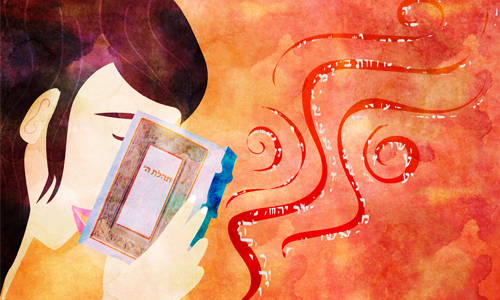 Chunks of time roll by without me even thinking to say thank you, without me remembering or acknowledging the gift of three years ago. Back then, when I was in the rush of the moment—and felt the awareness of G‑d and gratitude so deeply—my intention was to fill my life with this. And yet, daily life happens, triggers surface, other details take centerLife happens, triggers surface stage, and things get taken for granted. But right now, on the anniversary of my daughter’s heart surgery, I put my complacency on hold and go within to find my place of gratitude, where I still aspire to live from.
Chunks of time roll by without me even thinking to say thank you, without me remembering or acknowledging the gift of three years ago. Back then, when I was in the rush of the moment—and felt the awareness of G‑d and gratitude so deeply—my intention was to fill my life with this. And yet, daily life happens, triggers surface, other details take centerLife happens, triggers surface stage, and things get taken for granted. But right now, on the anniversary of my daughter’s heart surgery, I put my complacency on hold and go within to find my place of gratitude, where I still aspire to live from.Rewind. My 2½-year-old is scheduled for open-heart surgery, and in my heart and mind there is so much at stake. Though we are at peace with our decision to go ahead with it and are placing her in the hands of the best surgeon in the world for a procedure that’s supposed to be somewhat “straightforward,” there is the fear of one wrong move and, of course, of the unknown: How will she react to surgery and all that it entails? We are scared. Scared of the letting go and scared by the tasks that we have certain control over leading up to it, like preventing her from eating that morning (it’s necessary to fast beforehand). Fruit is her daily elixir, her coffee, and I simply cannot fathom how she will bypass that routine. Somehow, we manage to.
And then we are en route to the hospital. It’s summer in Boston, early morning—my favorite time of day, when the air is crisp, and smells of vitality and possibility. We arrive and stop at the hospital fish tank for her to marvel at all the colors and patterns. For the next few days, we, too, are going to be living in somewhat of a tank—a bubble in time and space.
We go up and wait. I’d had my own bad experience with anesthesia as a child, with the associated loss of control, and I hope for her it will be smooth. We are very present, more than usual, drinking up the last few seconds with her before she gets wheeled away. She is chatting away and moving around, as always, as she converts the head of the hospital bed into her slide. “Will she ever be able to do this again? Will she retain her character and curiosity and innocence? Are they really about to wheel her away and cut her chest open? Is this happening?”
And then, she is in their hands. She is in the hands of G‑d, as always, but now we feel this truth acutely. In the waiting room, I look out the big windows at the world that is beginning another “usual” day. But here inside, so many very different outcomes await so many very different people. A collective holding of breath takes place in this place, where people are privy to perspective on life, where they are not distracted by the non-truths many times we choose to focus on.
Before we know it, we are looking into the kind face of the surgeon, who comes out to let us know how it went. Thank G‑d, it went well. We are on the other side.
The other side is a journey itself, from watching her turn blue as they pull her off life support later that same day, to keeping fully on top of her medication doses and vital signs, to just lying and being with her, to playing in the magical hospital playroom. We are blessed with nurses that are both professional and human, and the smoothest of experiences. Thank G‑d, within days, we are in a cab out of there.
Fast-forward three years. It is the anniversary itself, and we are heading to the beach to celebrate, a life-affirming activity, I think. But even on the day, I find myself frustrated by the length of our journey and various details around it, and still find myself weighed down by the responsibility for my daughter’s well-being, as if it is in my hands(as if it ever was). I am impatient. I am not present. I am aware I am impatient and not present. I judge myself.
But later in the day, as she sits facing forward on my lap on the train and we watch the fields roll by together, I say to her with feeling and conviction how much I love her. And as I kiss her head and hold her tight, I let tears flow silently and steadfastly down my cheeks. Tears of appreciation, tears of love, tears of awe, tears of fears of not being a good enough mother and tears for not appreciating it all as I once resolved.
Oh, the challenge of life. We experienceI’m sorry for the missed opportunities events that we take for granted, instead of allowing them to infuse our lives with perspective and meaning. For example, all the many times I didn’t knock someone over while driving carelessly. I don’t even think about this, let alone hold it in my mind’s eye and mutter thank you again and again, especially when I find myself preoccupied by things that don’t really count.
I am sorry for the missed opportunities to live in constant gratitude since the surgery, but now is where I have power. When I catch myself feeling sorry for myself or weighed down by life, as is inevitable, I intend to hone in the surgery, and choose to accept and absorb the valuable gifts within. I will mutter thank you again and again, and appreciate my daughter’s life anew and life as a whole.
Everything’s OK (perfect, really). Thank you!
Loren is a writer who is passionate about figuring out life and sharing the lessons she learns in a real and honest way. An avid magazine reader and writer, she also posts regularly on her blog in the hope that readers will be left feeling heard, less alone and inspired. Originally from South Africa, she now lives in Jerusalem with her husband and daughters.
Artwork by Sefira Ross, a freelance designer and illustrator whose original creations grace many Chabad.org pages. Residing in Seattle, Washington, her days are spent between multitasking illustrations and being a mom.© Copyright 2016, all rights reserved.
-------
Story
Karl the Janitor by Menachem Posner
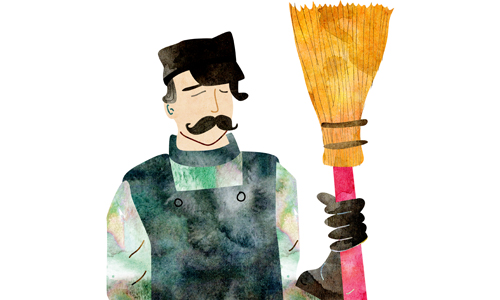 There was once a poor but righteous man who lived on the road leading to Liozna. Every day, he would walk to Liozna, where he would teach Torah to some neighborhood children in exchange for a few pennies from their impoverished parents.
There was once a poor but righteous man who lived on the road leading to Liozna. Every day, he would walk to Liozna, where he would teach Torah to some neighborhood children in exchange for a few pennies from their impoverished parents.His wife further supplemented their income by bakingSuddenly, they were awakened by a knock on the door pastries, which her husband would distribute to customers in town every day.
One winter’s night, the family lay sleeping. Suddenly, they were awakened by a knock on the door. Clutching a candle, the teacher hastened to open the door. There he found a man half frozen and covered in snow.
The wayfarer was quickly brought inside and given a steaming cup of tea to drink. After the stranger had warmed himself, the teacher took his sleeping children from their paillasse on the stove (which was the warmest place in the house) and bade the traveler to lie down and stretch his weary bones there.
Early the next morning, the stranger departed. The children, still groggy with sleep and stiff with cold, crept back onto the stove to finish their sleep.
Suddenly, a call rang out. “There’s something hard and lumpy in the bed!”
Upon further inspection, the teacher and his wife realized that the stranger had left a pouch with a significant sum of gold coins.
They waited a few days for the guest to claim his property, but he never returned.
Unsure of how to proceed, the man turned to the Alter Rebbe, who lived in Liozna at the time.
After hearing the man’s story, the Rebbe replied, “G‑d has sent you this treasure. No one will come to claim it, and it is rightfully yours. However, it is not wise for you to begin to spend lavishly, since people will suspect all kinds of things. Rather, keep your change of fortune a secret for now. Finish teaching your pupils this semester. When the session ends, come to me, and I’ll tell you what to do next.”
When the semester ended, the teacher came to the Alter Rebbe, who then advised him: “Rent yourself a house in town with a store. Use your coins to purchase some supplies from the local wholesaler and begin to sell them at a profit. After this succeeds, come back to me in a year, and I’ll advise you further.”
One year later, the erstwhile teacher reported: “Thank G‑d, business has prospered and we have been living quite well. In fact, we drew just a few coins from the treasure that we found in the stove.”
The Alter Rebbe then advised him to extend his business dealings, purchasing directly from the supplier in Vitebsk instead of the local wholesaler.
Another year passed, and the man reported that business had flourished even more and that he still had the vast majority of his coins to invest.
This time, the Alter Rebbe advised him to travel to Moscow, from whence the Vitebsk suppliers purchased their wares, and to sell his stock to merchants in Vitebsk and Liozna.
A year passed, and fortune continued to smile down upon him. The Alter Rebbe told him to travel to Konigsberg, which would allow him to sell even to the Moscow businessmen.
And so it was. The onetime poor teacher and pastry seller became a well-respected businessman with extensive dealings all across Russia.
Once, before departing on a business trip, the entrepreneur"This is not what I had in mind," said the Alter Rebbe came to seek the blessing and advice of the Alter Rebbe. “You’re traveling to Konigsberg,” noted the Rebbe. “Perhaps you can bring back a gift for me.”
Honored that the Rebbe deigned to ask him for a gift, the man went to the finest shop in Konigsberg and purchased an expensive golden snuff box.
“This is a fine gift,” said the Alter Rebbe when the man returned, “but this is not what I had in mind.”
On his next trip, the man purchased an even more expensive snuff box, but again the Rebbe said that it was not what he wanted.
Before the man’s next trip, the Rebbe told him. “You’re traveling to Konigsberg. Do you perhaps go to the theater there?”
A sincere chassid and pious Jew, the businessman had never been to the theater in his life, but on this trip he dutifully purchased a ticket to a show in the Konigsberg theater. He settled into the plush seat in the private box high above the stage and promptly fell asleep.
Tired from his business dealings, the man slept soundly and was only jolted awake when the janitor entered his booth to clean it.
“Where did you come from?” asked the janitor, who was not accustomed to seeing sleeping chassidim in the expensive theater seats (or any theater seats for that matter).
“From White Russia,” came the reply.
“From which city?”
“From Liozna.”
“Do you perhaps know Zalminya?” said the cleaner, using a familiar appellation for the Alter Rebbe, whose full name was Schneur Zalman.
“Indeed, I do. In fact, I am a student of his.”
“If so, please give him my regards.”
“But what is your name?”
“Call me Karl.”
Sure enough, upon his return to Liozna, the chassid dutifully gave the Alter Rebbe regards from Karl, the theater cleaner.
“Yes,” exclaimed the Rebbe. “That was the gift I had been hoping for.”
Before the man’s next trip to Konigsberg, the Alter Rebbe gave him a small package to bring to Karl. “When you get to Konigsberg,” said the Alter Rebbe, “please give this to him. And then, when you are ready to go home, please take it from him and bring it back to me.”
Upon his arrival, the businessman quickly found Karl at the theater and gave him the package. When it was time to go, he again sought out the theater cleaner to retrieve the package.
“Did Zalminya say that I need to give it back?” asked Karl,The Alter Rebbe gave him a small package to bring to Karl opening the package. He lovingly withdrew a sheaf of papers with the Alter Rebbe’s handwriting. They would soon be printed and gain fame as the Tanya, the Alter Rebbe’s foundational work of Chassidic thought.
“Divine inspiration,” he repeated to himself as he leafed through the pages. “True divine inspiration . . . I don’t know what will be left for Moshiach himself to teach.”
With that, he closed the packaged and returned it to the businessman.
When telling this story, the famed Rabbi Shmuel Gonim Estherman would conclude: It seems that Karl was among the 36 hidden tzadikim (righteous men), and the Alter Rebbe wanted his approval for the Tanya.
Rabbi Menachem Posner serves as staff editor for Chabad.org.
Artwork by Sefira Ross, a freelance designer and illustrator whose original creations grace many Chabad.org pages. Residing in Seattle, Washington, her days are spent between multitasking illustrations and being a mom.© Copyright 2016, all rights reserved.
-------
Jewish News
Completion of Sixth Children’s Torah Scroll Celebrated in Jerusalem by Chabad.org Staff
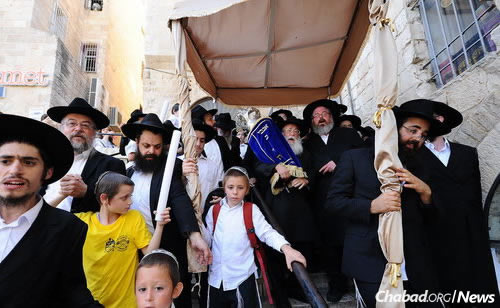 The writing of the sixth “children’s Torah scroll” was finished last week in Jerusalem. Celebrants then carried the scroll through the Old City to the Western Wall (Kotel).
The writing of the sixth “children’s Torah scroll” was finished last week in Jerusalem. Celebrants then carried the scroll through the Old City to the Western Wall (Kotel).1,828,830. That’s the number of Jewish children who have purchased letters in special “children’s Torah scrolls,” the sixth of which was finished last week in Jerusalem.
In the spring of 1981, the Rebbe—Rabbi Menachem M. Schneerson, of righteous memory—spoke of the special power children have to make the world a better place. Quoting the Talmudic description of their speech as “breath free of sin,” the Rebbe explained that they can fuel a dramatic demonstration of unity that could change the planet.
To that end, the Rebbe urged that every Jewish child possess a letter in a Torah scroll written specifically for them. All it would cost is the symbolic amount of one dollar (or its equivalent in local currency), ideally coming from the child’s own funds or sponsored by parents and family members. Each letter would link Jewish children the world over to the foundation of their heritage and to each other.
The Rebbe also asked that the Torah scroll be written in Israel, “the land where the Eyes of the L‑rd your G‑d are upon it at all times, from the beginning of the year until the end of the year.” The Rebbe specified the Old City of Jerusalem as the location for the writing of the Torah scroll. This is because Jerusalem also represents “the concept of unity,” as it was never divided among the tribes and was the focal point of the people in Israel. The Rebbe further requested that the Torah scroll be written in the Tzemach Tzedek synagogue—the only synagogue in the Old City whose walls and roof remained intact throughout the Jordanian occupation between 1948 and 1967.
Every Torah scroll contains 304,805 letters; writing a complete one usually takes a whole year. But the campaign—launched with the backing of rabbinical leaders, such as Rabbi Israel Abuchatzera and Rabbi Moshe Feinstein in Israel and New York, respectively—sparked such enthusiasm that the first children’s Torah scroll was successfully completed in just three-and-a-half months.
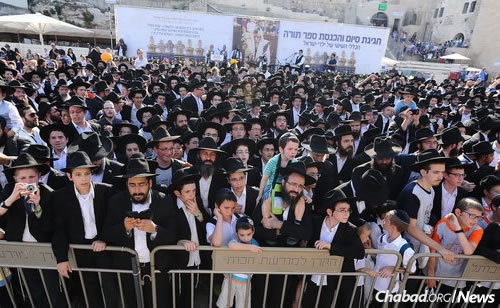 Thousands turned out at the Western Wall Plaza to mark the completion of the scroll.
Thousands turned out at the Western Wall Plaza to mark the completion of the scroll.That first scroll was finalized on the 20th day of the Hebrew month of Av, 5741 (1981). Exactly 35 years later, the sixth Torah scroll was finished in the same place.
Thousands gathered on Thursday at the Western Wall (Kotel) in Jerusalem to celebrate its completion. Honored guests included Jerusalem Chief Rabbi Shlomo Moshe Amar, Rabbi of the Western Wall Shmuel Rabinowitz and leading Chabad-Lubavitch rabbis from throughout Israel.
The writing of the seventh Torah scroll has already begun. Letters can be purchased online or via mail (still for just a dollar). Every child receives a colorful certificate with his or her Hebrew name on it and the portion of the Torah where his or her letter can be found.
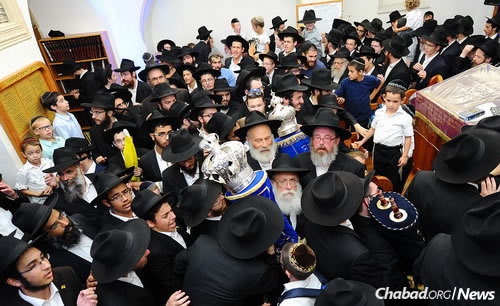 Dancing with the new Torah at the historic Tzemach Tzedek synagogue in the Old City.© Copyright 2016, all rights reserved.
Dancing with the new Torah at the historic Tzemach Tzedek synagogue in the Old City.© Copyright 2016, all rights reserved.-------
Jewish News
New Generation of Rabbinic Scholars Join Their Mentors at Upstate N.Y. Conference
by Menachem Posner
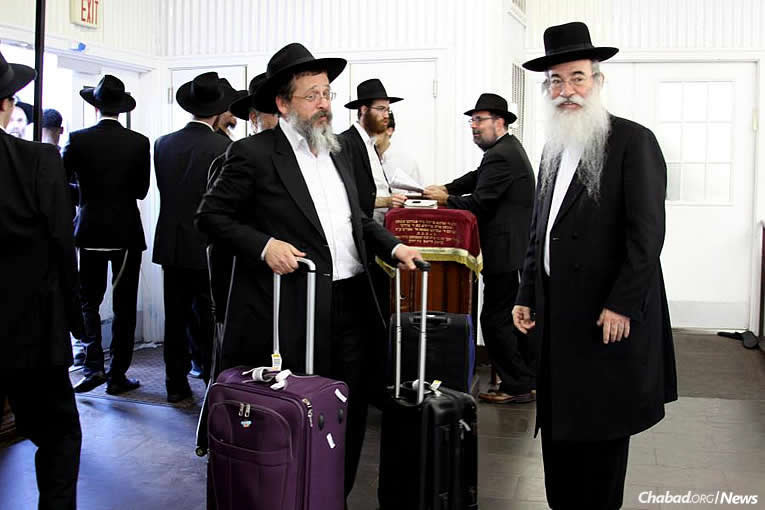 Rabbinic leaders, Talmudic scholars and Torah educators arrive in New York City for a scholarly conference known as Yarchei Kallah. Before they headed Upstate, many of them visited the Ohel—the resting place of the Lubavitcher Rebbe. (Photo: Meni Ben Shahar)
Rabbinic leaders, Talmudic scholars and Torah educators arrive in New York City for a scholarly conference known as Yarchei Kallah. Before they headed Upstate, many of them visited the Ohel—the resting place of the Lubavitcher Rebbe. (Photo: Meni Ben Shahar)Dozens of rabbinic leaders, Talmudic scholars and Torah educators gathered last weekend for a scholarly conference at Camp Gan Israel, the venerable Chabad-Lubavitch overnight camp in Parksville, N.Y.
The high-level conference known as Yarchei Kallah (literally, “months of the bride”—alluding to the marriage of the Jewish people to G‑d through Torah)—was held under the auspices of Agudas Chassidei Chabad, the umbrella organization for the worldwide Chabad-Lubavitch movement. It is named for the medieval conferences when Babylonian scholars and laymen would gather semi-annually for month-long learning.
This year, many of the attendees were up-and-coming rabbis and scholars, sharing the podium with contemporaries sometimes more than double their age.
“For me, it is particularly moving to interact with my teachers and mentors from my yeshivah years,” says Rabbi Avrohom Lapidus, rosh yeshivah (head of academy) of the historic Torat Emet yeshivah, which was founded in Hebron in 1914 by the fifth Chabad Rebbe—Rabbi Sholom Dovber of Schneersohn, of righteous memory—and relocated to Jerusalem after the World War I. “There is so much discussion on such a variety of topics that it is impossible not to come away with a storehouse of new ideas and perspectives for the coming school year.”
Conference organizer Rabbi Avraham Shemtov, chairman of Agudas Chassidei Chabad called the annual retreat “a gathering of the best and brightest.” He added that “the mere fact that [the rabbinical leaders] get together in one place is a reason for celebration.”
On Saturday night, following Shabbat, the wider community attended a melava malka meal where rabbis and scholars presented talks on Jewish law, Talmud, Chassidic teachings and more, especially on the voluminous writings of Rabbi Levi Yitzchak Schneerson, father of the Lubavitcher Rebbe—Rabbi Menachem M. Schneerson, of righteous memory.
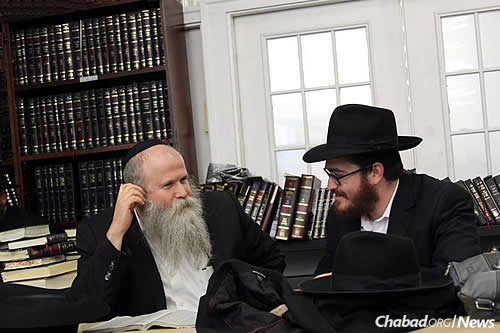 The discussions between rabbis, those younger and those more seasoned, began right away. (Photo: Meni Ben Shahar)
The discussions between rabbis, those younger and those more seasoned, began right away. (Photo: Meni Ben Shahar)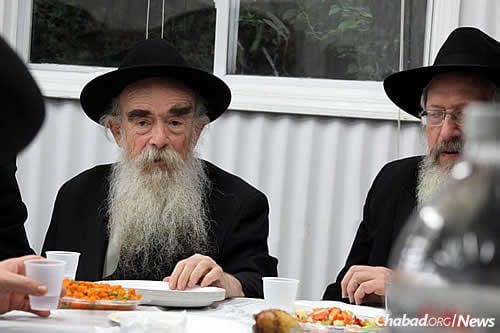 Conference organizer Rabbi Avraham Shemtov, chairman of Agudas Chassidei Chabad, the umbrella organization for the worldwide Chabad-Lubavitch movement (Photo: Meni Ben Shahar)
Conference organizer Rabbi Avraham Shemtov, chairman of Agudas Chassidei Chabad, the umbrella organization for the worldwide Chabad-Lubavitch movement (Photo: Meni Ben Shahar)Learning, Experience and Wisdom
Since 1974, the Yarchei Kallah has taken place around the 20th day of the Hebrew month of Av, the anniversary of passing of Rabbi Levi Yitzchak, who was the chief rabbi of Yekaterinoslav (currently Dnepropetrovsk, Ukraine). He passed away in 1944 in Kazakhstan, having been exiled by the Soviets for his fearless leadership and determination to fight for the Jewish community’s right to serve G‑d in freedom.
The Rebbe welcomed the Yarchei Kallah initiative, which was founded to mark 30 years since his father’s passing, and noted with satisfaction that it was to be held at Gan Israel. Organizers point to the convergence of advanced Torah learning among the crowds of children as highlighting convergent key aspects of the Rebbe’s father’s life, beginning with his self-sacrifice on behalf of Jewish education for the young in the face of Soviet persecution and culminating with his lifelong devotion to advanced Torah scholarship.
They say it is especially noteworthy that half-a-dozen of the more than 50 attendees will be younger than 50, many of them the sons of longtime attendees of the summit.
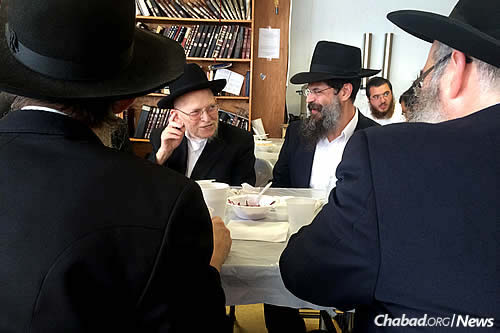 Rabbi Yisroel Friedman, left, rosh yeshivah of Oholei Torah in Brooklyn, N.Y., catches up with former student Rabbi Avrohom Lapidus, rosh yeshivah (head of academy) of the historic Torat Emet yeshivah (Photo: Meni Ben Shahar)
Rabbi Yisroel Friedman, left, rosh yeshivah of Oholei Torah in Brooklyn, N.Y., catches up with former student Rabbi Avrohom Lapidus, rosh yeshivah (head of academy) of the historic Torat Emet yeshivah (Photo: Meni Ben Shahar)In the words of Lapidus: “We get so much from this weekend. We learn a lot from the speakers, and we learn even more from the informal discussions that spring up between sessions. There is so much learning, so much experience and so much wisdom that we gain from mingling with our own rabbis and mentors.”
Rabbi Yisroel Friedman, rosh yeshivah of Oholei Torah in Brooklyn, N.Y., is known worldwide for the vast corpus of Talmudic commentary he has committed photographically to memory, an uncanny and razor-sharp analytical approach to discerning the underlying connective themes between seemingly disparate Talmudic exegeses, and for his clear legal renderings on a wide range of issues. At the same time, the 80-year-old sage has taught and mentored thousands of students. Many of them serve today as leading rabbis, teachers and rosh yeshivahs around the world.
Over the decades, his former students—regardless of their place in the Torah world—have ascribed their love for Torah learning to the rabbi, and expressed their appreciation and admiration for his humility and humor.
Rabbi Friedman, who has attended every conference since 1974, says he looks forward to meeting his former students (Lapidus being one of them) and seeing how much they have advanced since they sat in his classroom.
“It is a point of pride to visit with people who were once students,” he said, “and have now become teachers and leaders in their own right.”
-------
Jewish News
The Return: 500 European Rabbis Gather in Village of Lubavitch by Dovid Margolin
The Return: 500 European Rabbis Gather in Village of Lubavitch by Dovid Margolin
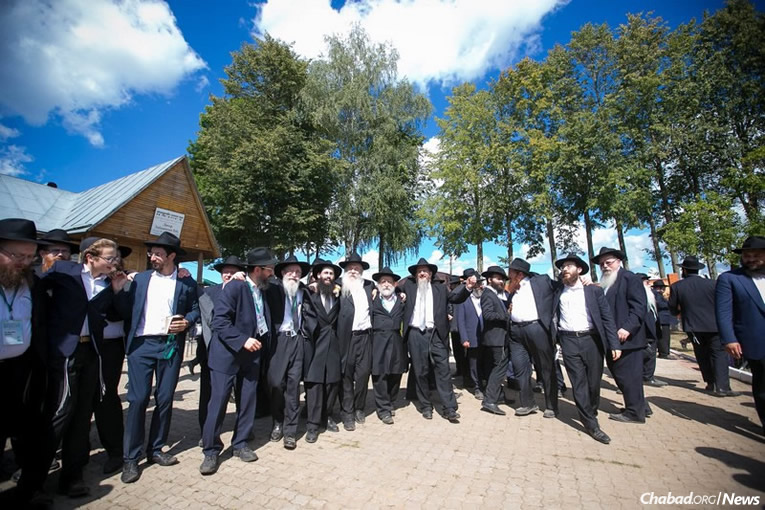 For almost 500 Chabad rabbis from throughout Europe who gathered at a conference in Russia, it was not just a time to discuss the many challenges facing their Jewish communities, but to celebrate, pray and reflect at many of the sites of the movement's founding that were closed to religious activity during the Soviet era. (Photo: Yehezkel Itkin)
For almost 500 Chabad rabbis from throughout Europe who gathered at a conference in Russia, it was not just a time to discuss the many challenges facing their Jewish communities, but to celebrate, pray and reflect at many of the sites of the movement's founding that were closed to religious activity during the Soviet era. (Photo: Yehezkel Itkin)For four days this week, some 500 Chabad-Lubavitch rabbis from across Europe are gathering in Moscow, Russia, for the largest rabbinical summit in recent European history. The historic meeting, which underscores the unprecedented growth of Jewish life and infrastructure in Russia during the last quarter-century, is not taking place in Moscow alone, however. On Sunday evening, fleets of buses departed the Russian capital, ferrying the rabbis—who hail from nearly every European capital and country—to the tiny villages where the movement was born nearly 250 years ago: Lubavitch (Lyubavichi), Russia; Liozna, Belarus; and Liadi (Lyady), Belarus.
On Tuesday, the group boarded flights to Almaty, Kazakhstan, where they will mark the 72nd anniversary of the passing of Rabbi Levi Yitzchak Schneerson, the father of the Lubavitcher Rebbe—Rabbi Menachem M. Schneerson, of righteous memory—who is buried in the central Asian city where he died in Soviet-imposed exile in 1944.
While certainly momentous, it’s not the first time that Chabad has chosen Russia to host its annual European gathering. Back in the summer of 1991, 170 Chabad rabbis arrived in the terminally ill Soviet Union for the first time to inspire a land that had been sealed off for generations and to witness the beginnings of what has since become the greatest renaissance in Jewish history.
“It took place in [Soviet leader Mikhail] Gorbachev’s final months in power,” remembers Rabbi Moshe Kotlarsky, vice chairman of Merkos L’Inyonei Chinuch—the educational arm of the Chabad-Lubavitch movement—who flew from New York at the time to run the gathering. “It was very emotional for all of us. We landed in Moscow’s airport, and there was an announcement in Russian, English and Hebrew welcoming the emissaries of the Lubavitcher Rebbe to the Soviet Union. At the time, who could have imagined such a thing?”
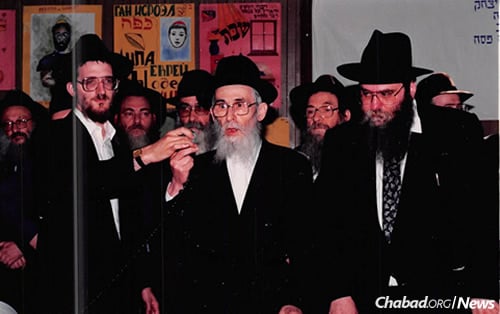 In 1991, at the first rabbinic conference to be permitted in the Soviet Union in decades, Rabbi Berel Lazar, left, and Rabbi Moshe Kotlarsky, right, flank Rabbi Issocher Dov Gurevitch, the longtime director of the Beth Rivkah Lubavitch girls’ school in Yerres, France, who was imprisoned twice by Soviet secret police and illegally escaped in the late 1940s. (Photo: Kinus.com)
In 1991, at the first rabbinic conference to be permitted in the Soviet Union in decades, Rabbi Berel Lazar, left, and Rabbi Moshe Kotlarsky, right, flank Rabbi Issocher Dov Gurevitch, the longtime director of the Beth Rivkah Lubavitch girls’ school in Yerres, France, who was imprisoned twice by Soviet secret police and illegally escaped in the late 1940s. (Photo: Kinus.com)Among that first group were a number of Russian-born emissaries who had fled the Soviet Union years earlier, such as Rabbi Issocher Dov Gurevitch, the longtime director of the Beth Rivkah Lubavitch girls’ school in Yerres, France, who passed away in 2008 at the age of 93. Gurevitch had been imprisoned twice by Soviet secret police and illegally escaped in the late 1940s. The rabbi was terrified to return to the country of his birth.
“He was extremely scared when he gave his passport to the Soviet customs agent,” says his grandson, Rabbi Mendel Gurevitch, who is attending the current gathering as a rabbi from Germany. “When he saw what was going on with Judaism in the USSR, he was amazed. He talked about it for years later.”
The elder Gurevitch was 23 when he and another Chassid were arrested after being caught teaching a group of children Torah in an empty synagogue in Berdichev, Ukraine. The children were sent to Soviet orphanages, and the two rabbis sentenced to a year of prison. Arriving back in Moscow in 1991, Gurevitch and his colleagues traveled to Chabad’s Camp Gan Israel—then in just its second summer—where he emotionally retold the story, asking the Russian Jewish children to “take full advantage of the new opportunities available.”
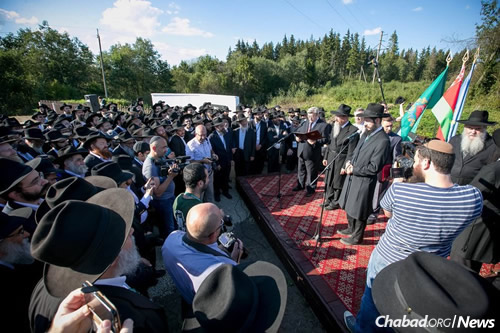 Twenty-five years after the historic 1991 gathering, Rabbi Moshe Kotlarsky, far right, and Rabbi Berel Lazar, third from right, were again among the rabbis and dignitaries on hand. (Photo: Yehezkel Itkin)
Twenty-five years after the historic 1991 gathering, Rabbi Moshe Kotlarsky, far right, and Rabbi Berel Lazar, third from right, were again among the rabbis and dignitaries on hand. (Photo: Yehezkel Itkin)Twenty-five years later, his grandson, co-director of Chabad of Offenbach am Main near Frankfurt, is being amazed once again. In 1991, there were just three permanent Chabad rabbis in the USSR: Rabbi Berel Lazar in Moscow, Rabbi Shmuel Kaminezki in Dnepropetrovsk and Rabbi Moshe Moskovitz in Kharkov. Today, the Federation of Jewish Communities of the CIS (FJC) boasts a presence in more than 250 cities throughout the former Soviet Union, nearly 100 of them with permanent rabbis.
Walking through Moscow’s seven-story Marina Roscha Jewish Community Center, Gurevitch recalls a story his grandfather used to tell him about the old days, when Marina Roscha’s synagogue was little more than a wooden hut and attending it came at a heavy price.
“The police grabbed him, and told him they’d let him go if he agreed to report to their office once a week and report on all the activities in Marina Roscha synagogue,” recounts Gurevitch. “He went straight back to the synagogue and told everyone exactly what happened to him. Rather than inform, he ran away to Tashkent [Soviet Uzbekistan].”
These days, Tashkent has a Chabad presence as well. Would Gurevitch have been able to visit now, he would be greeted by rabbis and a chorus of children at the Ohr Avner Jewish Day School.
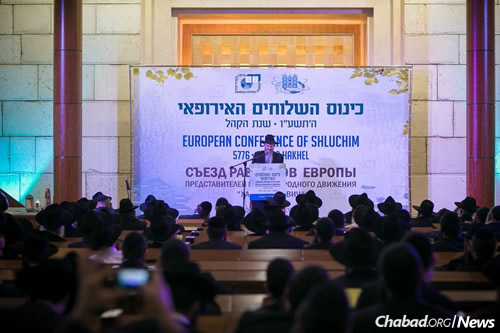 (Photo: Yehezkel Itkin)
(Photo: Yehezkel Itkin)‘Like It Came Back to Life’
“Every town and townlet has its own chapter in Jewish history,” wrote Rabbi Yosef Yitzchak, the Sixth Chabad Rebbe (1880-1950). “There are towns and townlets that represent in themselves complete movements and complete periods in Jewish life. Such a town, or rather townlet, was Lubavitch in Russia. During 102 years and 2 months, Lubavitch was the seat of four generations of Chabad Rebbes, and the center of Chabad Chasidism with hundreds of thousands of followers all over Russia as well as in other countries.”
In the fall of 1915, as World War I engulfed Europe, that period came to an end. The Fifth Rebbe, Rabbi Shalom Dov Ber, evacuated his Chassidic court from the village where his father and grandfather—leaders of Lubavitch—were buried and headed east to Rostov, Russia.
At that time, “Lubavitch ceased to be the seat of the Lubavitch Rebbes and the center of Chabad,” wrote Rabbi Yosef Yitzchak. “But the name ‘Lubavitch’ will always be bound up with Chabad Chasidism and will ever awaken sweet memories, and portray a wonderful chapter in Jewish history.”
In 1991, it took the rabbis 14 hours to reach the muddy village; nowadays, with newer roads and better buses, it takes seven. But the feeling, say participants, remains much the same.
“It was really unbelievable,” says Gurevitch by phone from a bus in Belarus. “All of these Chassidim walking along the streets of Lubavitch. For a few hours, if you looked around, it was like Lubavitch of old. It’s like it came back to life.”
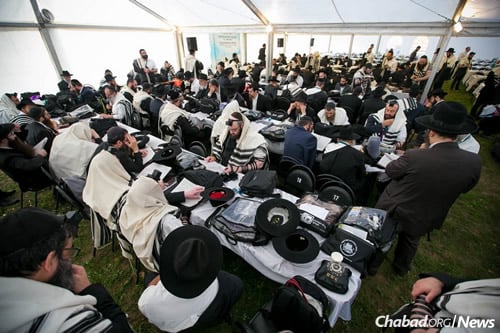
(Photo: Yehezkel Itkin)
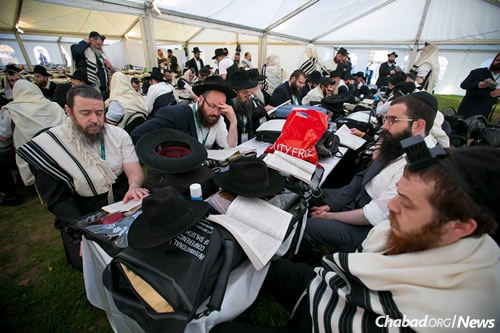
(Photo: Yehezkel Itkin)
On Monday in Lubavitch, the emissaries sang and prayed, gathering in a large white tent built for the occasion on the exact location of the historic court of the Lubavitcher Rebbes. Trudging along the perpetually muddy dirt roads, they made their way out to the long-silent Jewish cemetery, where an Ohel covers the resting place of the Tzemach Tzedek, Rabbi Menachem Mendel of Lubavitch (1789-1866); and his youngest son and successor Rabbi Shmuel (1834-1883).
Each year in November, emissaries from around the globe gather in New York for the annual International Conference of Chabad-Lubavitch Emissaries (Kinus Hashluchim). It’s a time to meet old friends, to study and learn, and, as so many of them say, “recharge their batteries.” Regional gatherings take place as well, allowing rabbis in local areas to learn and share with one another. With Europe facing an alarming rise in anti-Semitism and a relatively recent onslaught of terrorism, Chabad rabbis—who serve from a majority of the continent’s pulpits, including in isolated places such as Malmo, Sweden, or Athens, Greece—see the coming together in Russia occurring at a particularly important time.
“Every kinus is important, and the shluchim come away invigorated,” says Kotlarsky, who was instrumental in arranging the current gathering. “But for Lubavitch—having grown to such a large extent in Russia, in Europe and around the world—to come back to Lubavitch, it’s really special.”
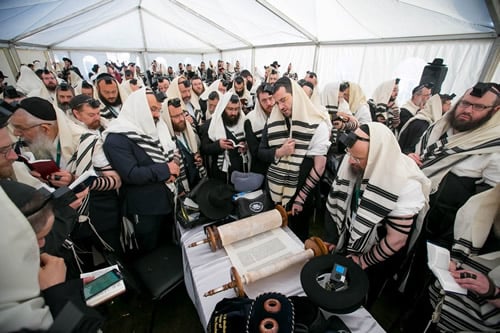 (Photo: Yehezkel Itkin)
(Photo: Yehezkel Itkin)A Century of Growth
Back in 1991, the Rebbe gave his blessings for the gathering, During the weeks that followed, he referred to it as “wondrous recent event,” drawing attention to the fact that rabbis from across Europe had been able to gather in the village of Lubavitch and in the capital of the Soviet Union to “seek advice and discuss matters with each other ... and make positive resolutions to add to their work in the spreading of Torah and Judaism and spreading the wellsprings out into the entire country and the whole world.”
The Rebbe stressed the meeting’s uniqueness, and in a note to one of his secretaries said that it would be worthwhile for the group to visit the movement’s birthplaces of Liozna and Liadi, both of which are today in Belarus. The note reached the rabbis in Moscow late, and although they had made the trek to Lubavitch and the flight to the resting place of the Rebbe’s father in Almaty, they never did make it to the two Belarussian villages.
It was in Liozna that Chabad was first founded in the late 1700s by Rabbi Schneur Zalman of Liadi, known as the Alter Rebbe, and it was there that his daughterDevorah Leah tragically passed away and was buried in 1792. After his second arrest by Czarist officials in 1801, Rabbi Schneur Zalman settled in Liadi, with which his name has been synonymous ever since. It was to Liadi that Napoleon Bonaparte famously came in search of the holy rabbi who stood in opposition to the French emperor’s conquest of Europe. These villages have been mostly empty of Jews since World War II, when the local populations were killed by the advancing Nazis.
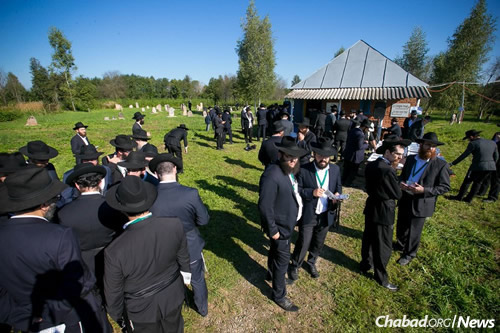 (Photo: Yehezkel Itkin)
(Photo: Yehezkel Itkin)On Monday evening, the emissaries’ buses crossed into Belarus, where they were greeted in each village by delegations of regional and local governments, as well as residents. “Every window was open; the people couldn’t believe their eyes,” says Gurevitch. “We had never seen these places, but they had never seen anything close to 500 rabbis.”
The group will fly from Moscow to Almaty, Kazakhstan, where they will pray at the gravesite of Rabbi Levi Yitzchak Schneerson on his yahrtzeit, the 20th day of the Hebrew month of Av (starting on the evening of Aug. 23 and lasting through the evening of Aug. 24).
“This has been a momentous century and a century of change,” says Lazar, the chief rabbi of Russia. “One hundred years ago, Lubavitch left the village of Lubavitch. Seventy-five years ago, the Rebbe left Europe and arrived in America, which began a new phase in the work of Chabad. Fifty years ago, the Rebbe began speaking about ‘Uforatzta’—spreading out, creating the network that you see today. And 25 years ago, Communism fell and the Soviet Union crumbled, which was the beginning of the revival of Russian Jewry.
“It is important to mark milestones, which is what we are doing. But it also means that the work is not complete; the next step is just beginning.”

(Photo: Yehezkel Itkin)
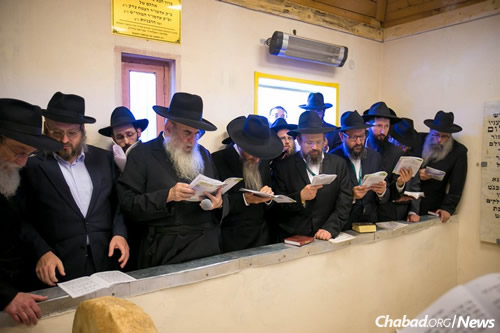
(Photo: Yehezkel Itkin)
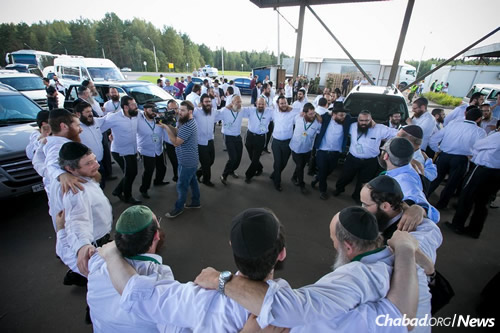
(Photo: Yehezkel Itkin)
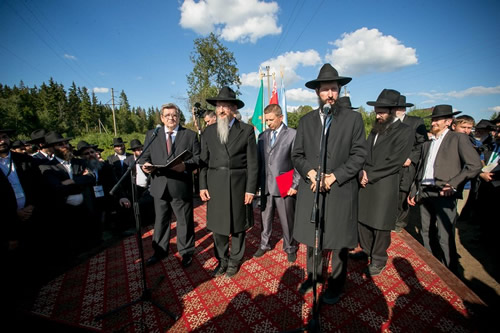
(Photo: Yehezkel Itkin)
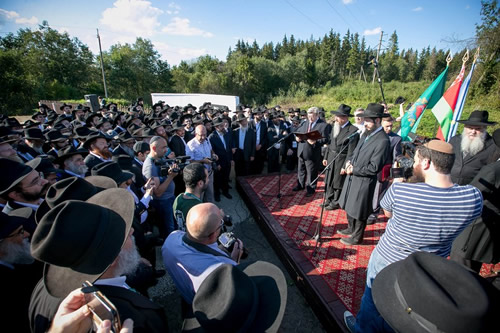
(Photo: Yehezkel Itkin)
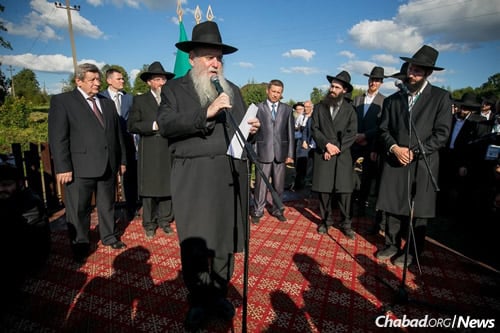
(Photo: Yehezkel Itkin)
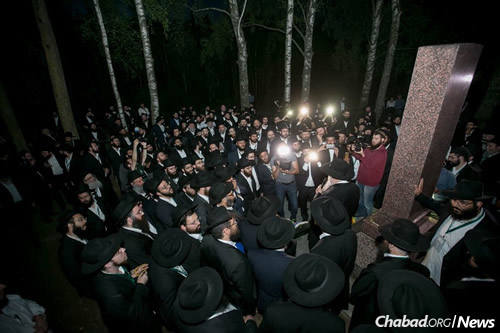
(Photo: Yehezkel Itkin)
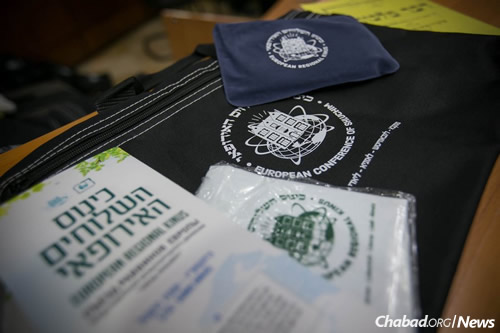
(Photo: Yehezkel Itkin)
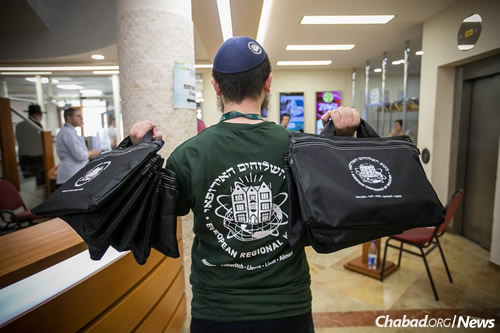
(Photo: Yehezkel Itkin)
Photos From the 1991 Kinus in Moscow
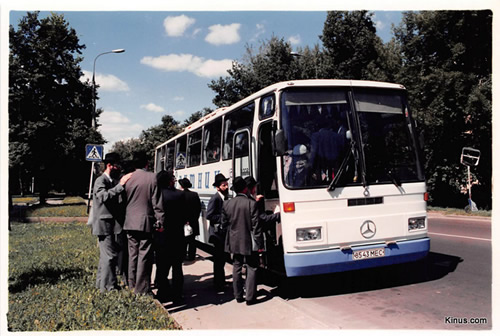
From 1991 Kinus (Photo: Kinus.com)
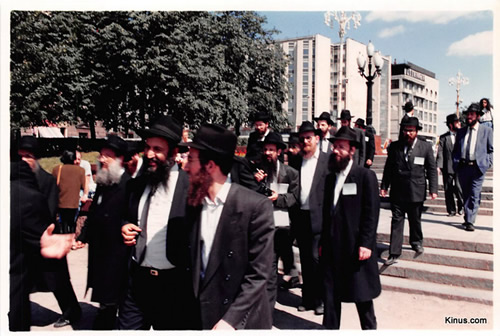
From 1991 Kinus (Photo: Kinus.com)
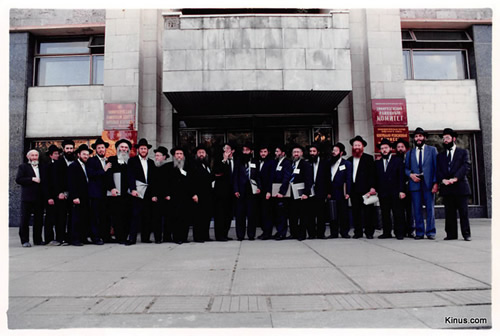
From 1991 Kinus (Photo: Kinus.com)
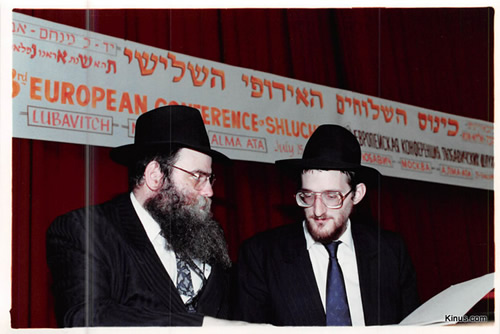
From 1991 Kinus (Photo: Kinus.com)
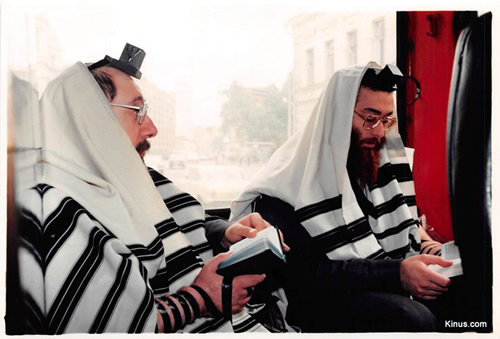
From 1991 Kinus (Photo: Kinus.com)
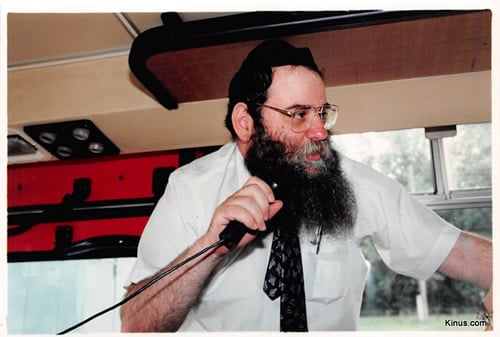
From 1991 Kinus (Photo: Kinus.com)
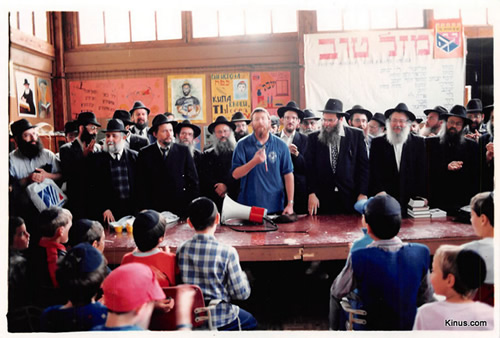
From 1991 Kinus (Photo: Kinus.com)
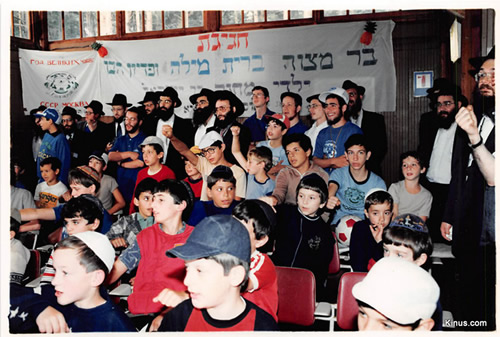
From 1991 Kinus (Photo: Kinus.com)
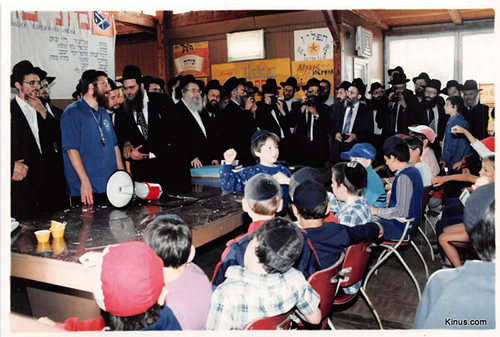
From 1991 Kinus (Photo: Kinus.com)
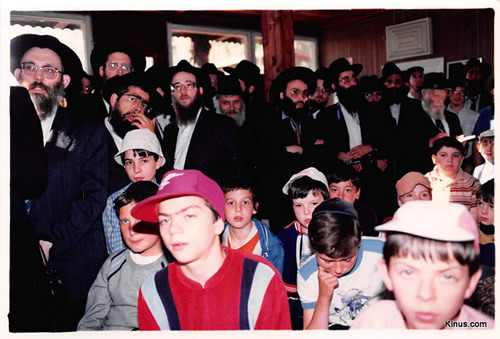
From 1991 Kinus (Photo: Kinus.com)
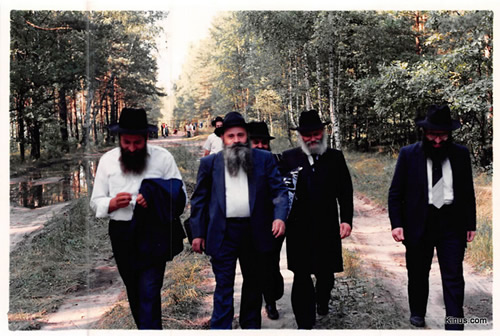
From 1991 Kinus (Photo: Kinus.com)
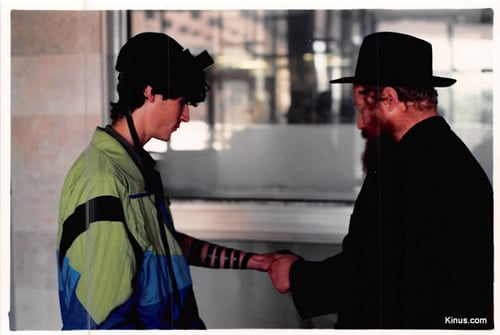
From 1991 Kinus (Photo: Kinus.com)
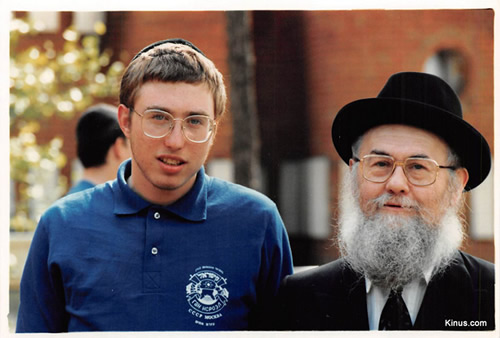
From 1991 Kinus (Photo: Kinus.com)© Copyright 2016, all rights reserved.
-------
Jewish News
He’s an Emissary Beloved by IDF Soldiers, and He Has His Own Story to Tell by Shlomo Rizel
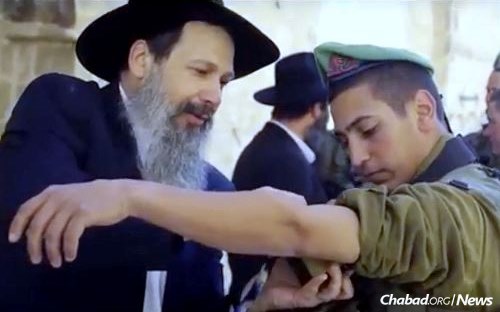 Rabbi Viktor Atia puts tefillin on an Israeli soldier.
Rabbi Viktor Atia puts tefillin on an Israeli soldier.For two days, my calls went unanswered. “I’m sorry I didn’t get back to you sooner,” Rabbi Viktor Atia tells me on the third day, “but I was in Vienna, Austria, telling my life story to four different audiences.”
Rabbi Viktor Atia, 52, is a Chabad-Lubavitch emissary in Kiryat Arba, on the outskirts of the holy city of Hebron. The residents of the city, as well as the many soldiers who provide security for them, know him well. They admire his inexhaustible efforts and make it a point to greet the beloved figure who always seems to be out and about. He is married to Devora. A native of the town, she is the daughter of legendary painter Baruch Nachshon. They have 12 children.
The rabbi was born in the coastal Israeli town of Bat Yam and grew up in a traditional home. “We used to make a ‘television Kiddush.’ In other words, we made Kiddush with the TV on and watched Hebrew-language films. Shabbat was a day for beach games, soccer and similar pursuits. I was a good athlete, excelling at the high jump, and my life looked wonderful, but inside I felt hollow. Then it happened—a friendly Chabadnik suggested that I put on tefillin. Even though I didn’t want to, I thought maybe it could fill that emptiness. I thought about the words of the prayers, but they didn’t speak to me.”
Still, Viktor began to spend his Friday nights at the Chabadnik’s home. He was taken by the Torah and the singing, and within a year, he was a member of the Chabad community. “You could say that, beyond Chabad’s compelling outlook on life and its purpose, the lifestyle spoke to me. I loved the idea of loving every Jew just because.”
After their marriage, it was natural for the young couple to search for a post as Chabad emissaries, preferably one close to Devora’s parents. That’s how they found themselves organizing activities for the people of Kiryat Arba and the soldiers of the area.
The rabbi’s winning smile and pleasant demeanor made him a beloved figure in the community, and their activities increased alongside their growing family.
Viktor tells his story and smiles, but there’s deep pain hidden behind the smile. On the 20th of Av, 5766, which this year corresponded to Aug. 14 (“I can’t believe that 10 years have flown past so quickly”), everything changed.
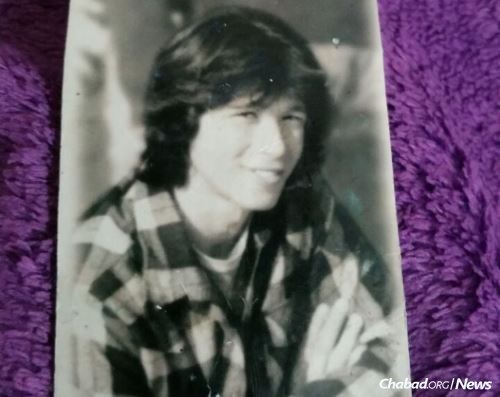 Viktor Atia in his youth
Viktor Atia in his youth‘My Life Had Gone Into a Tailspin’
It was the last few days of the Second Lebanon War. The rabbi went to comfort a family whose oldest child died in combat in southern Lebanon. “The soldier’s father was furious with G‑d. He was taking it very hard. I was trying my hardest to explain to him that the fate of everyone and everything is decided in Heaven, and that it’s all for the best, in the big picture, but that there are parts of the picture we can’t see. I felt the father’s pain, and was trying to encourage him and cheer him up, when my phone rang. Rabbi Danny Cohen, Chabad emissary from Hebron, was on the line. He told me that there was a fire near my house and that I’d better come. It didn’t sound too dramatic, so I asked him to keep me posted. But when my wife phoned, I knew in my heart that something bad had happened. I heard her scream, ‘Viktor, come home immediately, Chaya Mushka has been burned,’ and I knew that my life had just gone into a tailspin.”
Viktor jumped into his car and sped to Kiryat Arba. What alarmed him even more was a phone call made to his friend who was in the car with him. “He covered the phone with his hands so that I wouldn’t hear. That flooded my mind with memories of a time when I got a call about a terror attack and did the same thing; I was trying to hide the knowledge from family members of the murdered, who were standing next to me.”
Viktor vacillated between hope and despair, and begging G‑d to let him know how Chaya Mushka, the seventh of his 12 children, was faring. He opened a Chitat (book containing the Five Books of Moses, Tanya, Psalms and prayer book) that he had in the car and searched for a sign. The book opened to Ethics of the Fathers, and Viktor’s eyes were drawn to the Mishnah customarily a funeral: “Akabia ben Mehallel said: Contemplate three things ... ”
“It was like a knife piercing my heart. I put my head down and said, ‘G‑d, I understand Your message.’ ” When he got to Kiryat Arba, he saw a crowd around his house. Viktor approached a bystander and asked him: “Is it true that they weren’t able to save Chaya Mushka?” The man burst out crying, hugged him, and said: “Blessed be the True Judge,” the traditional phrase of acceptance of G‑d’s decree.
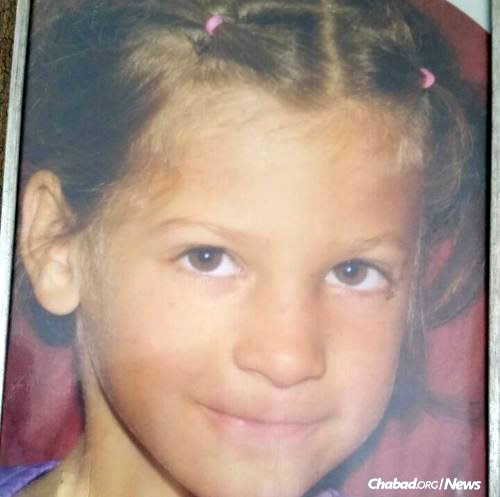 Chaya Mushka Atia, o.b.m.
Chaya Mushka Atia, o.b.m.Later, they found out that Chaya Mushka, who had never played with matches in her life until that day, was playing, with her sister, with a box of matches that they’d found at the edge of the courtyard. “She’d never handled fire before, so she panicked and didn’t know what to do, and her dress caught fire. Her sister, who was by her side, yelled at her to rip off the dress, but Chaya Mushka, who had been extraordinarily particular about modesty all her life, said that without her dress she would be immodest.”
By the time someone heard their screams and understood what was happening, it was too late.
‘Either Take Me Away or Raise Me Up’
Viktor felt he was going to collapse. “I raised my eyes heavenward and told G‑d, ‘You’ve given me the hardest possible test. I can’t pass it. It’s too much for me. Either do me a favor and take me, too, or give me the strength to bear this decree.”
The following days were too terrible to bear. Viktor and Devora couldn’t stop crying day or night. The main thing they missed was Chaya Mushka “calling out” to them. “We called her ‘Talking Eyes’ at home. She was quiet and shy, and she always connected with us through her eyes. It was exceptional. Those searching eyes—those sweet, childish eyes—were gone. They could no longer look at us and tell us things. After a few days, we stopped crying when the children were around, but at night, when we retired to our room, all it took was for one of us to look at the other, and we found ourselves wordless and crying. It’s impossible to describe the pain. It feels like something is cutting into you, like someone’s doing surgery without anesthesia. It feels like a limb has been torn off, and you’re left feeling like half a person.”
Even now, 10 years later, he has to hold back tears. I thought about stopping the interview here and continuing sometime in the future, but Viktor explained that what came next was a part of the story that couldn’t be left out.
What relieved their pain were the thousands of efforts of people from all over the world to comfort them, most of them by people they didn’t know. The Atia family knew that although they were suffering a personal pain, many Jews felt that pain as if it were their own. It was proof that their daughter had found her way into many hearts.
‘The Jewish Nation at Its Best’
In addition to the phone calls, strangers came to speak to them and hug them. “We felt like people were sharing our pain, trying to understand it and to make it easier for us. The Jewish nation was showing itself at its best.” The chief rabbi of Russia, Rabbi Berel Lazar, who didn’t know them before the tragedy, began to phone Viktor to comfort him and to share with him that he’d lost his own daughter at the age of 7. Rabbi Moshe Kotlarsky, director of the International Conference of Chabad Emissaries, phoned to tell about the death of his brother and how the Lubavitcher Rebbe encouraged his family at that time.
They knew that the tragedy had G‑d’s approval. Viktor isn’t sure he wants to tell me how he knew that, but after a while, he does. One of his sisters-in-law dreamt that she saw one of her deceased grandmothers drawing Chaya Mushka close to her and holding her, saying “She’s ours now.” The sister-in-law grabbed Chaya Mushka’s arm and shouted, “No, she’s ours!” But after a short struggle, her grandmother said that Chaya Mushka wanted to come with her and was doing it of her own free will, and that her doing so cancelled a terrible decree. In real life, on the same day as the dream, a group of terrorists planning a bombing attack were captured after the bomb they were preparing exploded.
“I cried a lot the first year. I got teary when I thought about her. I might be walking down the street, in the synagogue or talking to someone, and I’d burst out crying. My friends didn’t know what had happened to me, but when I explained, they stood silent; they realized that this was an indescribable pain.”
Emerging From the Darkness
Then Viktor knew that he had to stop, so that his children wouldn’t lose their father as well. “I decided that in spite of the agony and the darkness, I was going to ‘grow wings’ and fly above this. I could either stay where I was and sink into depression, or I could take charge of my life and keep moving forward. The push was knowing that Chaya Mushka was watching me, judging me with her deep-seeing eyes and asking me, wordlessly, to overcome my sorrow. I did it for her, so as not to hurt her, but also for myself and my family. I’m going on in spite of my sorrow.
“My motto since that time has been that I have to rise from the ruins. I once heard that every man falls, but what’s special about a Jew is that he picks himself up again. And he doesn’t just pick himself up; he climbs to greater heights.”
He doesn’t hesitate to provide an example. “The tragedy made me appreciate what I have. It gave me a perspective that I didn’t have before. I look around and see that I have to appreciate and thank G‑d for all He’s given me, to be the father of that righteous, holy soul for all those years, to be the husband of my wonderful wife, the father of amazing children, and a son to the parents who love me. I did those things before, but now I’m coming from a much deeper place. I’ve become a new man in that respect.”
Chaya Mushka’s Home
He’s quiet for a moment, debating whether or not to say something more, and then he adds: “Everyone who enters the large Chabad House we’ve erected in her memory goes on and on about the warmth they find there, and how pleasant it is, but my heart aches every time I hear that because I know that it was built on the ashes of our tragedy. Still, I’m consoled by her providing the impetus to build this center that serves so many people.”
When Rabbi Atia speaks about the Chabad House, he’s talking about a building in the heart of Kiryat Arba that has become one of the central synagogues there, in which dozens of people pray daily. It houses a Jewish library, guest rooms with en-suite accommodations, a kollel for advanced study of Chassidism, and a cancer center that treats patients in a unique method. It’s filled on Shabbat with 150 children who come to enjoy treats, recite Torah verses, sing songs and hear a story.
“Children’s activities were Chaya Mushka’s ‘baby,’ and she was my baby,” he says.
“Even though it’s a central place and very active, and we’re brought in an emissary to keep it that way, we haven’t raised money yet for air-conditioners. The atmosphere is pleasant, but the building is freezing in the winter and boiling in the summer. A friend just came from New York, and he donated a token sum towards air-conditioners, but we’re still short 85 percent of the money. I pray that G‑d will provide the money by Chaya Mushka’s 10th anniversary, even though I’m a terrible fundraiser.”
While he’s talking about his dream for Chaya Mushka’s 10th yahrtzeit, he mentions another dream: “One of Chaya Mushka’s kindergarten teachers wrote a book about her, and how giving and modest she was. We dream of publishing this as a children’s book with pictures. It would be a book that demonstrates good character.”
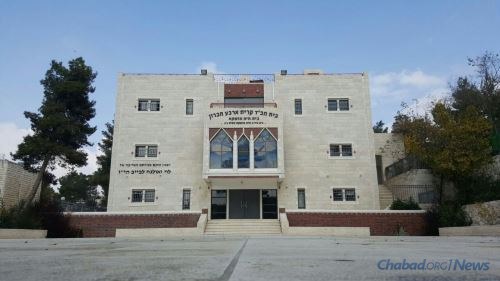 The Chaya Mushka Atia Chabad House in Kiryat Arba
The Chaya Mushka Atia Chabad House in Kiryat ArbaSpiritual Fortifications
I ask about the gunshots I hear in the background, but Viktor assures me that it’s normal and talks of a third dream, related to the gunfire. “Only if you can,” he emphasizes. “Bullet-proofing vehicles is very expensive, so we’ve decided to fortify every local vehicle for only 50 shekels. How? It’s very simple. We buy them Chitat books, which the Rebbe said would ensure the protection and success of everyone in the car, and distribute them for free.”
Since, as he says, he’s terrible at fundraising, it took Rabbi Atia six years to raise the money for the Chabad House. If not for good friends helping him and approaching serious donors, the building would still be in the planning stages. “One of the Chabad rabbis told me in the name of the Rebbe that building a memorial is healing. It helped heal our shattered hearts.”
That’s where Rabbi Atia’s speaking tours come in. The story of how he and his family have chosen life has gained international attention, and he has become a sought-after speaker all over the world.
“I emphasize two points. The first is that we have to appreciate what we have—to know that it’s not all coming to us for free, that we have to thank G‑d for everything. The second is that we have to always be happy, even when it’s hard. We have to channel the difficulties until they lift us above them.© Copyright 2016, all rights reserved.
-------
Chabad.org Magazine - Editor: Yanki Tauber
-------
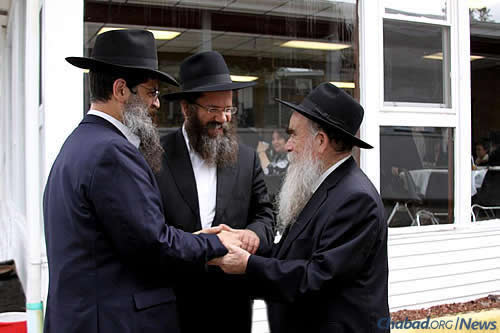
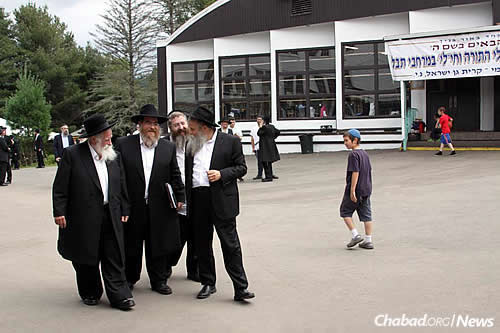
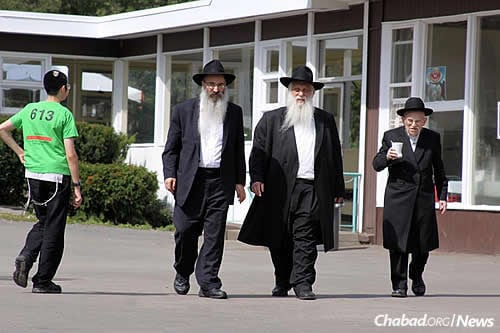
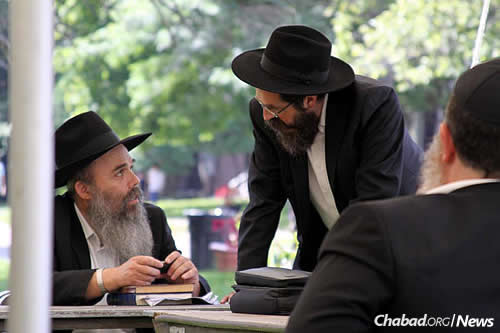
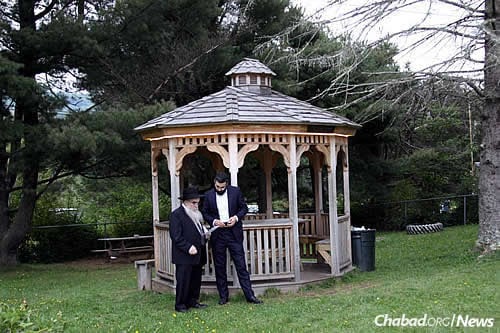
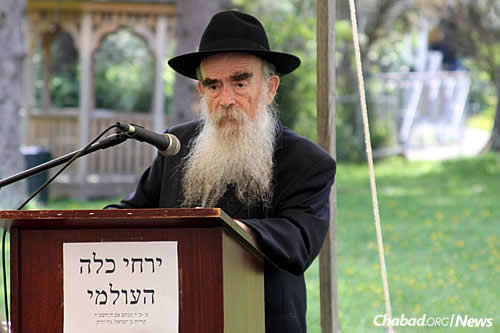
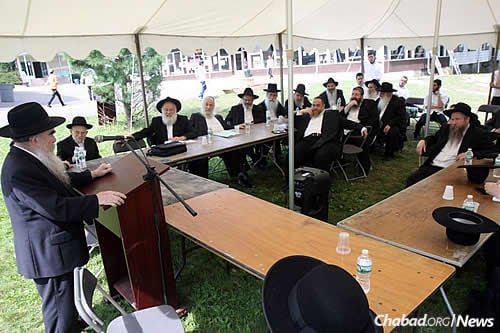
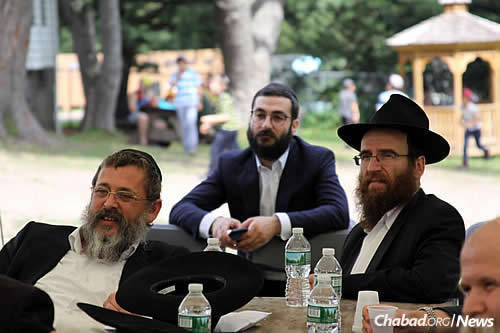
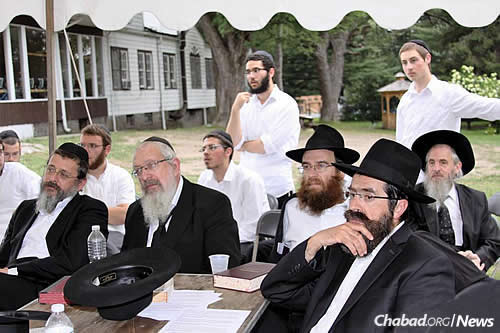
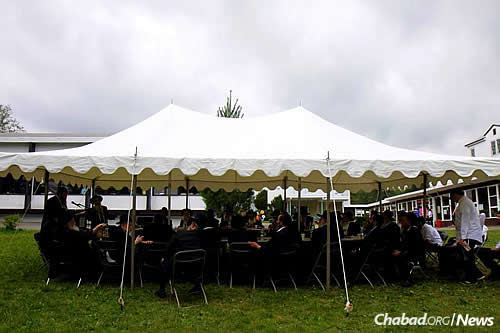
No comments:
Post a Comment